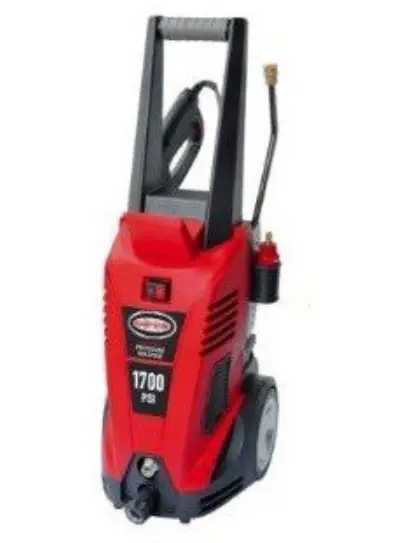Installation Manual
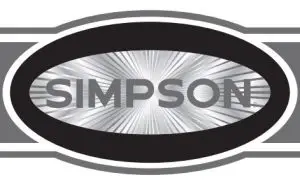
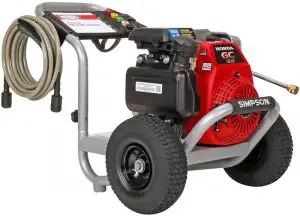
Simpson Premium Pressure Washer

If your pressure washer is not working properly or if there are parts missing or broken, please DO NOT RETURN IT TO THE PLACE OF PURCHASE. Contact our Customer
Service Department at 1-877-362-4271 or www.simpsoncleaning.com
IMPORTANT: Please make certain that the person who is to use this equipment carefully
reads and understands these instructions before operating.
Save this manual for Future reference
SAFETY GUIDELINES – DEFINITIONS
This manual contains information that is important for you to know and understand. This information relates to protecting YOUR SAFETY and PREVENTING EQUIPMENT PROBLEMS. To help you recognize this information, we use the symbols below. Please read the manual and pay attention to these symbols.
![]() DANGER: Indicates an imminently hazardous situation which, if not avoided, will result in death or serious injury.
DANGER: Indicates an imminently hazardous situation which, if not avoided, will result in death or serious injury.
Important Safety Instructions
![]() DANGER: Carbon Monoxide. Using an engine indoors can kill you in minutes. Engine exhaust contains high levels of carbon monoxide (CO), a poisonous gas you cannot see or smell. You may be breathing CO even if you do not smell engine exhaust.
DANGER: Carbon Monoxide. Using an engine indoors can kill you in minutes. Engine exhaust contains high levels of carbon monoxide (CO), a poisonous gas you cannot see or smell. You may be breathing CO even if you do not smell engine exhaust.
- NEVER use an engine inside homes, garages, crawlspaces or other partly enclosed areas. Deadly levels of carbon monoxide can build up in these areas. Using a fan or opening windows and doors does NOT supply enough fresh air.
- ONLY use outdoors and far away from open windows, doors and vents. These openings can pull in engine exhaust.
- Even when the engine is used correctly, CO may leak into your home. ALWAYS use a battery-powered or battery backup CO alarm in your house. Read and follow all directions for CO alarm before using. If you feel sick, dizzy or weak at anytime, move to fresh air immediately. See a doctor. You could have carbon monoxide poisoning.
![]() WARNING: Do not operate this unit until you read this instruction manual and the engine instruction manual for safety, operation and maintenance instructions. If you have any questions regarding the product, please contact our customer service department at www.simpsoncleaning.com.
WARNING: Do not operate this unit until you read this instruction manual and the engine instruction manual for safety, operation and maintenance instructions. If you have any questions regarding the product, please contact our customer service department at www.simpsoncleaning.com.
![]() Danger: Risk of injection or severe injury. Keep clear of nozzle. Do not direct discharge stream at persons or live animals. This product is to be used only by trained operators.
Danger: Risk of injection or severe injury. Keep clear of nozzle. Do not direct discharge stream at persons or live animals. This product is to be used only by trained operators.
![]() WARNING: This product and its exhaust contain chemicals known to the State of California to cause cancer, birth defects or other reproductive harm. In addition, some cleaning products and dust contain chemicals known to the State of California to cause cancer, birth defects or other reproductive harm. Wash hands after handling.
WARNING: This product and its exhaust contain chemicals known to the State of California to cause cancer, birth defects or other reproductive harm. In addition, some cleaning products and dust contain chemicals known to the State of California to cause cancer, birth defects or other reproductive harm. Wash hands after handling.
![]() WARNING: This product may not be equipped with a spark-arresting muffler. If the product is not equipped and will be used around flammable materials or on land covered with materials such as agricultural crops, forest, brush, grass or other similar items, then an approved
WARNING: This product may not be equipped with a spark-arresting muffler. If the product is not equipped and will be used around flammable materials or on land covered with materials such as agricultural crops, forest, brush, grass or other similar items, then an approved
spark arrester must be installed and is legally required in the state of California. It is a violation of California statutes section 130050 and/or sections 4442 and 4443 of the California Public Resources Code, unless the engine is equipped with a spark arrester, as defined in section 4442, and maintained in effective working order. Spark arresters are also required on some U.S. Forest Service land and may also be legally required under other statutes and ordinances.
Save these instructions


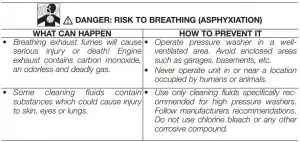
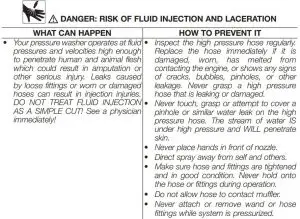
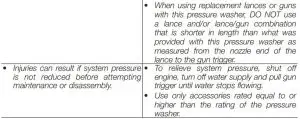

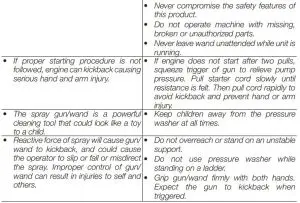

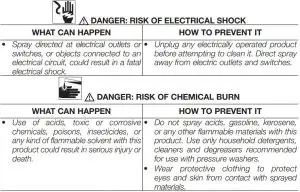
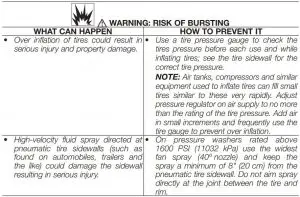
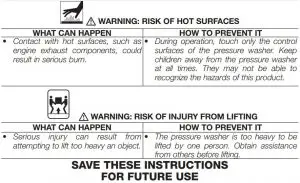
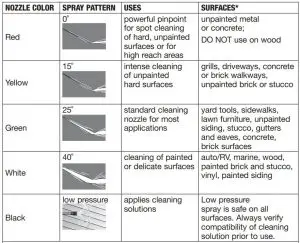
*NOTICE: The high pressure spray from your pressure washer is capable of causing damage to surfaces such as wood, glass, automobile paint, auto striping and trim, and delicate objects such as flowers and shrubs. Before spraying, check the item to be cleaned to assure yourself that it is strong enough to resist damage from the force of the spray.
Changing Nozzles on Spray Wand (Fig. 6)
![]() DANGER: Risk of fluid injection. Do not direct discharge stream toward persons, unprotected skin, eyes or any pets or animals. Serious injury will occur.
DANGER: Risk of fluid injection. Do not direct discharge stream toward persons, unprotected skin, eyes or any pets or animals. Serious injury will occur.
![]() WARNING: Flying objects could cause risk of serious injury. Do not attempt to change nozzles while pressure washer is running. Turn engine off before changing nozzles.
WARNING: Flying objects could cause risk of serious injury. Do not attempt to change nozzles while pressure washer is running. Turn engine off before changing nozzles.

- Pull quick-connect coupler (E) back and insert nozzle (K). 6
- Release quick-connect coupler and twist nozzle to make sure it is secure in coupler.
![]() WARNING: Flying object could cause risk of serious injury. Ensure nozzle is completely inserted in quick connect socket and quick-connect collar is fully engaged (forward) before squeezing gun trigger.
WARNING: Flying object could cause risk of serious injury. Ensure nozzle is completely inserted in quick connect socket and quick-connect collar is fully engaged (forward) before squeezing gun trigger.
How to APPLY chemicals/cleaning solvents (FIG. 7)
Applying chemicals or cleaning solvents is a low pressure operation. NOTE: Use only soaps and chemicals designed for pressure washer use. Do not use bleach.
To Apply Chemicals:

- Ensure detergent siphon hose (F, Figure 9) is attached to barbed fitting location near high pressure hose connection of pump as shown.
- Place other end of detergent siphon hose with filter on it into container holding chemical/cleaning solution. NOTE: For every 7 gallons of water pumped 1 gallon of chemical/cleaning solution will be used.
- Install low pressure (black) nozzle into quick connect fitting of spray wand, see How To Use Spray Wand paragraph in this section.
- After use of chemicals, place detergent siphon hose into container of clean water and draw clean water through chemical injection system to rinse system thoroughly. If chemicals remain in the pump, it could be damaged. Pumps damaged due to chemical residue will not be covered under warranty.
NOTE: Chemicals and soaps will not siphon if the black soap nozzle is not installed on the spray wand.
Starting (FIG. 8–11)
![]() WARNING: To reduce the risk of injury, read the pressure washer instruction manual and the engine instruction manual before starting pressure washer.
WARNING: To reduce the risk of injury, read the pressure washer instruction manual and the engine instruction manual before starting pressure washer.
![]() DANGER: Risk of fluid injection and laceration. When using the high pressure setting, DO NOT allow the high pressure spray to come in contact with unprotected skin, eyes, or with any pets or animals. Serious injury will occur.
DANGER: Risk of fluid injection and laceration. When using the high pressure setting, DO NOT allow the high pressure spray to come in contact with unprotected skin, eyes, or with any pets or animals. Serious injury will occur.
- Your washer operates at fluid pressures and velocities high enough to penetrate human and animal flesh, which could result in amputation or other serious injury. Leaks caused by loose fittings or worn or damaged hoses can result in injection injuries. DO NOT TREAT FLUID INJECTION AS A SIMPLE CUT! See a physician immediately!
![]() DANGER: Carbon Monoxide. Using an engine indoors can kill you in minutes. Engine exhaust contains high levels of carbon monoxide (CO), a poisonous gas you cannot see or smell. You may be breathing CO even if you do not smell engine exhaust.
DANGER: Carbon Monoxide. Using an engine indoors can kill you in minutes. Engine exhaust contains high levels of carbon monoxide (CO), a poisonous gas you cannot see or smell. You may be breathing CO even if you do not smell engine exhaust.
- Breathing exhaust fumes will cause serious injury or death! Engine exhaust contains carbon monoxide, an odorless and deadly gas.
- Operate pressure washer in a well-ventilated area. Avoid enclosed areas such as garages, basements, etc.
- Never operate unit in or near a location occupied by humans or animals.
![]() WARNING: Risk of Fire, Asphyxiation and Burn. Never fill fuel tank when engine is running or hot. Do not smoke when filling fuel tank.
WARNING: Risk of Fire, Asphyxiation and Burn. Never fill fuel tank when engine is running or hot. Do not smoke when filling fuel tank.
- Never fill fuel tank completely. Fill tank to 1/2″ (12.7 mm) below bottom of filler neck to provide space for fuel expansion. Wipe any fuel spillage from engine and equipment before starting engine.
- DO NOT let hoses come in contact with very hot engine muffler during or immediately after use of your pressure washer. Damage to hoses from contact with hot engine surfaces will NOT be covered by warranty.
NOTICE: Risk of property damage. Never pull water supply hose to move pressure
washer. This could damage hose and/or pump inlet.
- DO NOT use hot water, use cold water only.
- Never turn water supply off while pressure washer engine is running or damage to pump will result.
- DO NOT stop spraying water for more than two minutes at a time. Pump operates in bypass mode when spray gun trigger is not pressed. If pump is left in bypass mode for more than two minutes internal components of the pump can be damaged.
If you do not understand these precautions, please contact our customer service department at www.simpsoncleaning.com
Prior to starting, refer to your engine manual for proper starting procedure.
- In a well ventilated outdoor area add fresh, high quality, unleaded gasoline with a pump octane rating of 86 or higher. Do not overfill. Wipe up spilled fuel before starting the engine. Refer to Engine Owner’s Manual for correct procedure.

NOTICE: Use of fuels with greater than 10% ethanol are not approved for use in this product per EPA regulations and will damage the unit and void the warranty.
- Check engine oil level. Refer to Engine Owner’s Manual for correct procedure.
- Check pump oil level. The oil level should come to the dot in the middle of the sight glass. Refer to the Pump paragraph under Maintenance.
- Connect the water hose to the water source. Turn the water source on to remove all air from the hose. When a steady stream of water is present, turn the water source off.
- Verify the filter screen (O) is in water inlet of pump. NOTE: Convex side faces out.
- Connect water source (N) to pump inlet (J). NOTE: Water source must provide a minimum of 5 gallons per minute at 20 PSI.
- Connect high pressure hose (C) to pump outlet (I).

![]() WARNING: To reduce the possibility of contamination always protect against backflow when connected to a potable water system.
WARNING: To reduce the possibility of contamination always protect against backflow when connected to a potable water system.
- Choose the correct nozzle for the job to be performed. See How To Use spray Wand instructions in this section. NOTE: If applying a chemical or cleaning solution, see How To Apply Chemicals/Cleaning Solvents instructions in this section.
- Turn water source on.
NOTICE: Risk of property damage. Failure to do so could cause damage to the pump.
- Remove all air from the pump and high pressure hose by depressing trigger until a steady stream of water is present.
- Start engine. See Engine Owner’s Manual for correct procedure.
![]() WARNING: Risk of unsafe operation. If engine does not start after two pulls, squeeze trigger of gun to relieve pump pressure. Pull starter cord slowly until resistance is felt. Then pull cord rapidly to avoid kickback and prevent hand or arm injury.
WARNING: Risk of unsafe operation. If engine does not start after two pulls, squeeze trigger of gun to relieve pump pressure. Pull starter cord slowly until resistance is felt. Then pull cord rapidly to avoid kickback and prevent hand or arm injury.
Note: If the oil level in the engine is low, the engine will not start. If the engine does not start, check the oil level and add oil as needed.
- Depress trigger on gun to start water flow.
![]() WARNING: Risk of unsafe operation. Stand on a stable surface and grip gun/spray wand firmly with both hands. Expect the gun to kick when triggered.
WARNING: Risk of unsafe operation. Stand on a stable surface and grip gun/spray wand firmly with both hands. Expect the gun to kick when triggered.
- Release trigger to stop water flow.
![]() WARNING: Risk of injury from spray. Always engage the trigger lock (P) when gun is not in use. Failure to do so could cause accidental spraying.
WARNING: Risk of injury from spray. Always engage the trigger lock (P) when gun is not in use. Failure to do so could cause accidental spraying.
Shutting down

- After each use, if you have applied chemicals, place detergent siphon hose into container of clean water and draw clean water through chemical injection system to rinse system thoroughly.
NOTICE: Risk of property damage. Failure to do so could cause damage to the pump.
2. Turn engine off. See Engine Owner’s Manual.
NOTICE: Risk of property damage. NEVER turn the water off with the engine running.
3. Turn water source off.
4. Pull trigger on spray gun to relieve any water pressure in hose or spray gun.
NOTE: Failure to release system pressure will prevent removal of high pressure hose from spray gun or pump connection.
5. See Storage section in this manual for proper storage procedures.
Maintenance
![]() WARNING: Risk of burn hazard. When performing maintenance, you may be exposed to hot surfaces, water pressure or moving parts that can cause serious injury or death.
WARNING: Risk of burn hazard. When performing maintenance, you may be exposed to hot surfaces, water pressure or moving parts that can cause serious injury or death.
![]() WARNING: Risk of fire hazard. Always disconnect, spark plug wire, let the engine cool and release all water pressure before performing any maintenance or repair. The engine contains flammable fuel. Do not smoke or work near open flames while performing maintenance.
WARNING: Risk of fire hazard. Always disconnect, spark plug wire, let the engine cool and release all water pressure before performing any maintenance or repair. The engine contains flammable fuel. Do not smoke or work near open flames while performing maintenance.
To ensure efficient operation and longer life of your pressure washer, a routine maintenance schedule should be prepared and followed. If the pressure washer is used in unusual conditions, such as high-temperatures or dusty conditions, more frequent maintenance checks will be required.
ENGINE Consult the Engine Owner’s Manual for the manufacturer’s recommendations for any and all maintenance. NOTE: The engine drain plug is located at the rear of the unit.
PUMP (fig. 12)
NOTE: The Pump was filled with oil at the factory. The preferred oil is SIMPSON® Premium Pump Crankcase Oil. If this oil is not available, an SAE 15W-40 oil may be used. Change the pump oil after the first 50 hours of operation and every 100 hours thereafter, or every 3 months.
To Check Oil
The oil level should come to the dot in the middle of the sight glass (AA).
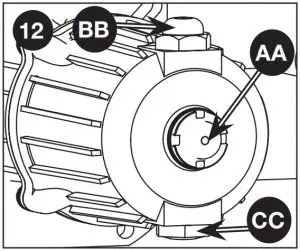
How To Change Pump Oil
- Loosen pump oil fill plug (BB).
- Place a container under the pump oil drain plug (CC).
- Remove pump oil drain plug.
- After oil is drained, replace pump oil drain plug. Tighten securely.
- Refill pump using SIMPSON® Premium Pump Crankcase Oil. If this oil is not available, an SAE 15W-40 oil may be used.
- Replace pump oil fill plug and tighten securely.
If there is a problem with the pump contact us at www.simpsoncleaning.com
Connections
Connections on pressure washer hoses, gun and spray wand should be cleaned regularly and lubricated with light oil or lithium grease to prevent leakage and damage to the o-rings.
NOZZLE CLEANING (fig. 13)
If the nozzle becomes clogged with foreign materials, such as dirt, excessive pressure may develop. If the nozzle becomes partially clogged or restricted, the pump pressure will pulsate. Clean the nozzle immediately using the nozzle kit supplied and the following instructions:

- Shut off the pressure washer and turn off the water supply.
- Pull trigger on gun handle to relieve any water pressure.
- Disconnect the spray wand from the gun.
- Remove the high pressure nozzle (K) from the spray wand. Remove any obstructions with the nozzle cleaning tool provided and back flush with clean water.
- Direct water supply (N) into nozzle to back flush loosened particles for 30 seconds.
- Reassemble the nozzle to the wand.
- Reconnect spray wand to gun and turn on water supply.
- Start pressure washer and place spray wand into high pressure setting to test.
CLEAN THE WATER INLET FILTER (FIG. 8)
This screen filter should be checked periodically and cleaned if necessary.
- Remove filter by grasping end and removing it from water inlet of pump.
- Clean filter by flushing it with water on both sides.
- Re-insert filter into water inlet of pump. NOTE: Convex side faces out.
NOTE: Do not operate the pressure washer without filter properly installed.
STORAGE
ENGINE
Consult the Engine Owner’s Manual for manufacturer’s recommendations for storage.
PUMP
The manufacturer recommends using SIMPSON® / POWERWASHER® Pump Guard or equivalent when storing the unit for more than 30 days and/or when freezing temperatures are expected. SIMPSON® / POWERWASHER® Pump Guard is environmentally friendly.
NOTE: Using pump guard helps provide proper lubrication to the internal seals of the pump regardless of temperature or environment.
NOTICE: Risk of property damage. Use only SIMPSON® / POWERWASHER® Pump Guard or equivalent. Other products could be corrosive and/or contain alcohol which may cause pump damage.
PRESSURE WASHER
- Drain all water from high pressure hose and wrap it onto hose wrap.
- Drain all water from the spray gun and wand by holding spray gun in a vertical position with nozzle end pointing down and squeezing trigger. Store in gun holder.
- Wrap up and secure detergent siphon hose so it is protected from damage.
ACCESSORIES
![]() DANGER: Risk of fluid injection. When using replacement spray wands or guns with this pressure washer, DO NOT use a spray wand and/or spray gun/ wand combination that is shorter in length than what was provided with this pressure washer as measured from the nozzle end of the wand to the gun trigger.
DANGER: Risk of fluid injection. When using replacement spray wands or guns with this pressure washer, DO NOT use a spray wand and/or spray gun/ wand combination that is shorter in length than what was provided with this pressure washer as measured from the nozzle end of the wand to the gun trigger.
NOTICE: The use of any other accessory not recommended for use with this tool could be hazardous. Use only accessories rated equal to or greater than the rating of the pressure washer.
Service Information
Do not return this product to your retailer. Please contact our customer service department at www.simpsoncleaning.com
LIMITED WARRANTY
The manufacturer of this product agrees to repair or replace designated parts that prove defective within the warranty period listed below at the manufacturer’s sole discretion. Specific limitations/extensions and exclusions apply.
This warranty covers defects in material and workmanship and not parts failure due to normal wear, depreciation, abuse, accidental damage, negligence, improper use, maintenance, water quality or storage. To make a claim under the terms of the warranty, all parts said to be defective must be retained and available for return upon request to a designated Warranty Service Center for warranty inspection. The judgments and decisions of the manufacturer concerning the validity of warranty claims are final.
These warranties pass through to the end user and are non-transferable. As a factory authorized and trained Warranty Service Center, the factory will honor the terms of all component warranties and satisfy claims of the appropriate warranty provisions.
Normal wear items include, but are not limited to, valves and seals, which are not covered by this warranty.
This warranty replaces all other warranties, express or implied, including without limitation any warranties of merchantability or fitness for a particular purpose and all such warranties are hereby disclaimed and excluded by the manufacturer. The manufacturer’s warranty obligation is limited to repair and replacement of defective products as provided herein and the manufacturer shall not be liable for any further loss, damages, or expenses – including damages from shipping, accident, abuse, acts of God, misuse, or neglect. Neither is damage from repairs using parts not purchased from the manufacturer or alterations performed by non-factory authorized personnel. Failure to install and operate equipment according to the guidelines put forth in the instruction manual shall void warranty.
This warranty does not cover the following: machines used for rental purposes, damage resulting from shipping (claims must be filed with freighter), accident, abuse, act of God, misuse, or neglect. Neither is damage from repairs or alterations performed by non-factory authorized personnel or failure to install and operate equipment according to the guidelines put forth in the instruction manual.
The manufacturer will not be liable to any persons for consequential damage, for personal injury, or for commercial loss.
Warranty does not apply to failures due to :
- Freight damage
- Damage due to chemical deterioration, scale build up, rust, corrosion or thermal expansion
- Freeze damage
- Damage caused by parts or accessories not obtained from an authorized dealer or not approved by the manufacturer.
- Normal wear of moving parts or components affected by moving parts.
Engine
Covered by engine manufacturer warranty. See engine manual.
High Pressure Pump (defects in material and workmanship)
Two (2) years from date of purchase.
Frame (defects in material and workmanship)
Ten (10) year from date of purchase.
OTHER COMPONENTS (defects in material and workmanship)
Includes nozzles, hoses, spray guns, wands, tires, feet
Ninety (90) days from date of purchase.
Trouble Shooting Guide
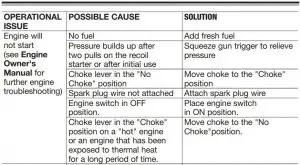
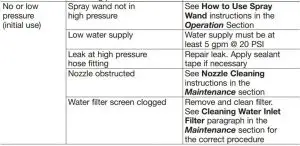
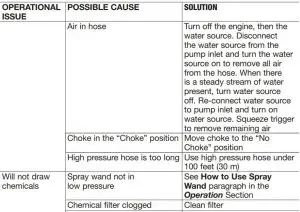


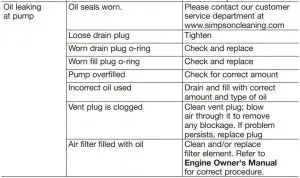
FNA Group, Inc.
Elk Grove Village, IL 60007
Internet Address: www.simpsoncleaning.com
Warranty Registration via Internet
Copyright. All Rights Reserved
Assembled in U.S.A with domestic and foreign components
]]>SIMPSON Premium Pressure Washer
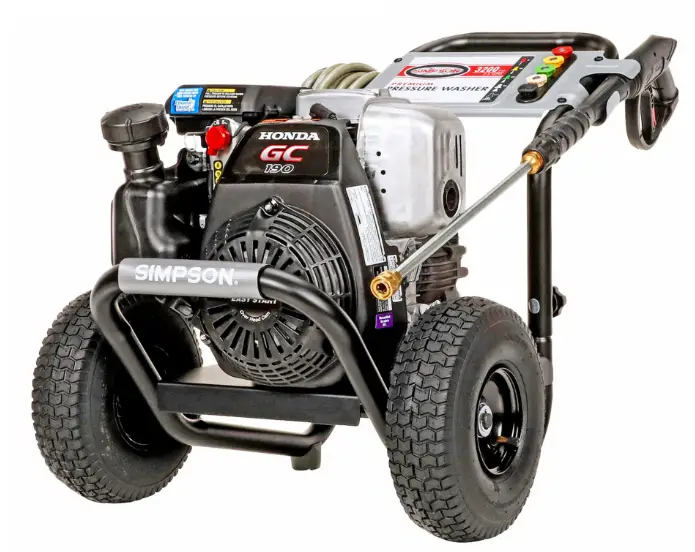
SIMPSON Premium Pressure Washer
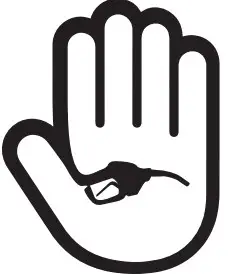 Look Before You Pump
Look Before You Pump
Do not use fuel containing greater than 10% Ethanol

If your pressure washer is not working properly or if there are parts missing or broken, please DO NOT RETURN IT TO THE PLACE OF PURCHASE. Contact our Customer Service Department at 1-877-362-4271 or www.simpsoncleaning.com
IMPORTANT: Please make certain that the person who is to use this equipment carefully reads and understands these instructions before operating.
SAFETY GUIDELINES – DEFINITIONS
This manual contains information that is important for you to know and understand. This information relates to protecting YOUR SAFETY and PREVENTING EQUIPMENT PROBLEMS. To help you recognize this information, we use the symbols below. Please read the manual and pay attention to these symbols.
 DANGER: Indicates an imminently hazardous situation which, if not avoided, will result in death or serious injury.
DANGER: Indicates an imminently hazardous situation which, if not avoided, will result in death or serious injury.
 WARNING: Indicates a potentially hazardous situation which, if not avoided, could result in death or serious injury.
WARNING: Indicates a potentially hazardous situation which, if not avoided, could result in death or serious injury.
 CAUTION: Indicates a potentially hazardous situation which, if not avoided, may result in minor or moderate injury.
CAUTION: Indicates a potentially hazardous situation which, if not avoided, may result in minor or moderate injury.
NOTICE: Indicates a practice not related to personal injury which, if not avoided, may result in property damage.
Important Safety Instructions
 DANGER: Carbon Monoxide. Using an engine indoors can kill you in minutes. Engine exhaust contains high levels of carbon monoxide (CO), a poisonous gas you cannot see or smell. You may be breathing CO even if you do not smell engine exhaust.
DANGER: Carbon Monoxide. Using an engine indoors can kill you in minutes. Engine exhaust contains high levels of carbon monoxide (CO), a poisonous gas you cannot see or smell. You may be breathing CO even if you do not smell engine exhaust.
- NEVER use an engine inside homes, garages, crawlspaces or other partly enclosed areas. Deadly levels of carbon monoxide can build up in these areas. Using a fan or opening windows and doors does NOT supply enough fresh air.
- ONLY use outdoors and far away from open windows, doors and vents. These openings can pull in engine exhaust.
- Even when the engine is used correctly, CO may leak into your home. ALWAYS use a battery-powered or battery backup CO alarm in your house. Read and follow all directions for CO alarm before using. If you feel sick, dizzy or weak at anytime, move to fresh air immediately. See a doctor. You could have carbon monoxide poisoning.
 WARNING: Do not operate this unit until you read this instruction manual and the engine instruction manual for safety, operation and maintenance instructions. If you have any questions regarding the product, please contact our customer
WARNING: Do not operate this unit until you read this instruction manual and the engine instruction manual for safety, operation and maintenance instructions. If you have any questions regarding the product, please contact our customer
service department at www.simpsoncleaning.com.
 Danger: Risk of injection or severe injury. Keep clear of nozzle. Do not direct discharge stream at persons or live animals. This product is to be used only by trained operators.
Danger: Risk of injection or severe injury. Keep clear of nozzle. Do not direct discharge stream at persons or live animals. This product is to be used only by trained operators.
 WARNING: This product and its exhaust contain chemicals known to the State of California to cause cancer, birth defects or other reproductive harm. In addition, some cleaning products and dust contain chemicals known to the State of California to cause cancer, birth defects or other reproductive harm. Wash hands after handling.
WARNING: This product and its exhaust contain chemicals known to the State of California to cause cancer, birth defects or other reproductive harm. In addition, some cleaning products and dust contain chemicals known to the State of California to cause cancer, birth defects or other reproductive harm. Wash hands after handling.
 WARNING: This product may not be equipped with a spark-arresting muffle.
WARNING: This product may not be equipped with a spark-arresting muffle.
If the product is not equipped and will be used around flammable materials or on land covered with materials such as agricultural crops, forest, brush, grass or other similar items, then an approved spark arrester must be installed and is legally required in the state of California. It is a violation of California statutes section 130050 and/or sections 4442 and 4443 of the California Public Resources Code, unless the engine is equipped with a spark arrester, as defined in section 4442, and maintained in effective working order. Spark arresters are also required on some U.S. Forest Service land and may also be legally required under other statutes and ordinances.
Save these instructions
 DANGER:
DANGER:
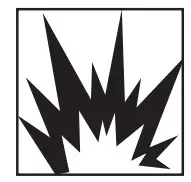 Risk of explosion or fire
Risk of explosion or fire
| What can happen | How to prevent it |
| • Spilled gasoline and it’s vapors can become ignited from cigarette sparks, electrical arcing, exhaust gases and hot engine components such as the muffler | • Shut off engine and allow it to cool before adding fuel to the tank. • Use care in filling tank to avoid spilling fuel. Move pressure washer away from fueling area before starting engine. |
| • Heat will expand fuel in the tank which could result in spillage and possible fire explosion. | • Keep maximum fuel level 1/2″ (12.7 mm) below bottom of filler neck to allow for expansion. |
| • Operating the pressure washer in an explosive environment could result in a fire. | Operate and fuel equipment in well-ventilated areas free from obstructions. Equip areas with fire extinguisher suitable for gasoline fires |
| • Materials placed against or near the pressure washer can interfere with its proper ventilation features causing overheating and possible ignition of the materials. | • Never operate pressure washer in |
| Muffler exhaust heat can damage painted surfaces, melt any material sensitive to heat (such as siding, plastic, rubber, vinyl or the pressure hose, itself), and damage live plants. | • Always keep pressure washer a minimum of 4′ (1.2 m) away from surfaces (such as houses, automobiles or live plants) that could be damaged from muffler exhaust heat. |
| Improperly stored fuel could lead to accidental ignition. Fuel improperly secured could get into the hands of children or other unqualified persons. | • Store fuel in an OSHA approved container, in a |
| • Use of acids, toxic or corrosive chemicals, poisons, insecticides, or any kind of flammable solvent with this product co | • Do not spray flammable liquids. |
| DANGER: RISK TO BREATHING (Asphyxiation) | |
| Breathing exhaust fumes will cause serious injury or death! Engine exhaust contains carbon monoxide, an odorless and deadly gas. | • Operate pressure washer in a wellventilated area. Avoid enclosed areas such as garages, basements, etc. • Never operate unit in or near a location occupied by humans or animals. |
| Some cleaning fluids contain substances which could cause injury to skin, eyes or lungs. | Use only cleaning fluids specifically recommended for high pressure washers. Follow manufacturers recommendations. Do not use chlorine bl |
 DANGER: RISK of FLUID INJECTION and Laceration DANGER: RISK of FLUID INJECTION and Laceration |
|
| Your pressure washer operates at fluid pressures and velocities high enough to penetrate human and animal flesh which could result in amputation or other serious injury. Leaks caused by loose fittings or worn or damaged hoses can result in injection injuries. DO NOT TREAT FLUID INJECTION AS A SIMPLE CUT! See a physician immediately! | • Inspect the high pressure hose regularly. Replace the hose immediately if it is damaged, worn, has melted from contacting the engine, or shows any signs of cracks, bubbles, pinholes, or other leakage. Never grasp a high pressure hose that is leaking or damaged. • Never touch, grasp or attempt to cover a pinhole or similar water leak on the high pressure hose. The stream of water IS under high pressure and WILL penetrate skin. • Never place hands in front of nozzle. • Direct spray away from self and others. • Make sure hose and fittings are tightened and in good condition. Never hold onto the hose or fittings during operation. • Do not allow hose to contact muffler. • Never attach or remove wand or hose fittings while system is pressurized. • When using replacement lances or guns with this pressure washer, do not use a lance and/or lance/gun combination that is shorter in length than what was provided with this pressure washer as measured from the nozzle end of the lance to the gun trigger. |
| • Injuries can result if system pressure is not reduced before attempting maintenance or disassembly | • To relieve system pressure, shut off engine, turn off water supply and pull gun trigger until water stops flowing. • Use only accessories rated equal to or higher than the rating of the pressure washer |
 DANGER: RISK OF INJURY FROM SPRAY DANGER: RISK OF INJURY FROM SPRAY |
|
| High-velocity fluid spray can cause objects to break, p | • Always wear ANSI-approved Z87.1 safety glasses. Wear protective clothing to protect against accidental spraying. • Never point wand at or spray people or animals. |
| • Light or unsecured objects can become hazardous projectiles. | • Always secure trigger lock when wand is not in service to prevent accidental operation. • Never permanently se |
 Danger: RISK of unsafe operation Danger: RISK of unsafe operation |
|
| What can happen | How to prevent it |
| • Unsafe operation of your pressure washer could lead to serious injury or death to you or others. | • Do not use chlorine bleach or any other corrosive compound. • Become familiar with the operation and controls of the pressure washer. • Keep operating area clear of all persons, pets and obstacles. • Do not operate the product when fatigued or under the influence of alcohol or drugs. Stay alert at all times. • Never compromise the safety features of this product. • Do not operate machine with missing, broken or unauthorized parts. • Never leave wand unattended while unit is running |
| If proper starting procedure is not followed, engine can kickback causing serious hand and arm injury | • If engine does not start after two pulls, squeeze trigger of gun to relieve pump pressure. Pull starter cord slowly until resistance is felt. Then pull cord rapidly to avoid kickback and prevent hand or arm injury |
| The spray gun/wand is a powerful cleaning tool that could look like a toy to a child | • Keep children away from the pressure washer at all times. |
| • Reactive force of spray will cause gun/ wand to kickback, and could cause the operator to slip or fall or misdirect the spray. Improper control of gun/ wand can result in injuries to self and others. | • Do not overreach or stand on an unstable support. • Do not use pressure washer while standing on a ladder. • Grip gun/wand firmly with both hands. Expect the gun to kickback when triggered. |
 DANGER: Risk of Injury or Property Damage When Transporting or storing DANGER: Risk of Injury or Property Damage When Transporting or storing |
|
| What can happen | How to prevent it |
| • Fuel or oil can leak or spill and could result in fire or breathing hazard. Serious injury or death can result. Fuel or oil leaks will damage carpet, paint or other surfaces in vehicles or trailers. • Oil could fill the cylinder and damage the engine if the unit is not stored or transported in an upright position |
• If pressure washer is equipped with a fuel shut-off valve, turn the valve to the off position before transporting to avoid fuel leaks. If pressure washer is not equipped with a fuel shut-off valve, drain the fuel from tank before transporting. Only transport fuel in an OSHA-approved container. Always place pressure washer on a protective mat when transporting to protect against damage to vehicle from leaks. Always transport and store unit in an upright position. Remove pressure washer from vehicle immediately upon arrival at your destination. |
 Danger: RISK OF electrical Shock Danger: RISK OF electrical Shock |
|
| • Spray directed at electrical outlets or switches, or objects connected to an electrical circuit, could result in a fatal electrical shock. | • Unplug any electrically operated product before attempting to clean it. Direct spray away from electric outlets and switches. |
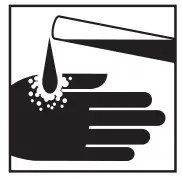 DANGER: RISK of chemical burn DANGER: RISK of chemical burn |
|
| • Use of acids, toxic or corrosive chemicals, poisons, insecticides, or any kind of flammable solvent with this product could result in serious injury or death. | • Do not spray acids, gasoline, kerosene, or any other flammable materials with this product. Use only household detergents, cleaners and degreasers recommended for use with pressure washers. • Wear protective clothing to protect eyes and skin from contact with sprayed materials. |
 WARNING: RISK of Bursting WARNING: RISK of Bursting |
|
| • Over inflation of tires could result in serious injury and property damage. | • Use a tire pressure gauge to check the tires pressure before each use and while inflating tires; see the tire sidewall for the correct tire pressure. NOTE: Air tanks, compressors and similar equipment used to inflate tires can fill small tires similar to these very rapidly. Adjust pressure regulator on air supply to no more than the rating of the tire pressure. Add air in small increments and frequently use the tire gauge to prevent over inflation. |
| • High-velocity fluid spray directed at pneumatic tire sidewalls (such as found on automobiles, trailers and the like) could damage the sidewall resulting in serious injury | • On pressure washers rated above 1600 PSI (11032 kPa) use the widest fan spray (40º nozzle) and keep the spray a minimum of 8″ (20 cm) from the pneumatic tire sidewall. Do not aim spray directly at the joint between the tire and rim. |
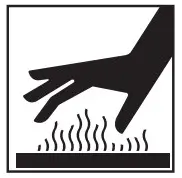 WARNING: RISK OF Hot surfaces WARNING: RISK OF Hot surfaces |
|
| • Contact with hot surfaces, such as engine exhaust components, could result in serious burn. | • During operation, touch only the control surfaces of the pressure washer. Keep children away from the pressure washer at all times. They may not be able to recognize the hazards of this product. |
| WARNING: RISK OF INJURY FROM LIFTING | |
| • Serious injury can result from attempting to lift too heavy an object | • The pressure washer is too heavy to be lifted by one person. Obtain assistance from others before lifting. |
SAVE THESE INSTRUCTIONS FOR FUTURE USE
| NOZZLE COLOR | SPRAY PATTERN | USES | SURFACES* |
|
Red |
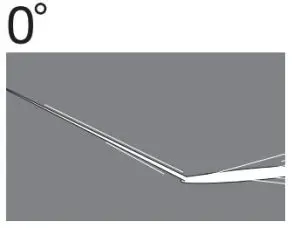 |
powerful pinpoint for spot cleaning of hard, unpainted surfaces or for high reach areas | unpainted metal or concrete;
DO NOT use on wood |
|
Yellow |
 |
intense cleaning of unpainted hard surfaces | grills, driveways, concrete or brick walkways, unpainted brick or stucco |
|
Green |
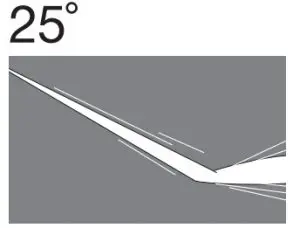 |
standard cleaning nozzle for most applications | yard tools, sidewalks, lawn furniture, unpainted siding, stucco, gutters and eaves, concrete, brick surfaces |
|
White |
 |
cleaning of painted or delicate surfaces | auto/RV, marine, wood, painted brick and stucco, vinyl, painted siding |
|
Black |
 |
applies cleaning solutions | Low pressure spray is safe on all surfaces. Always verify compatibility of cleaning solution prior to use. |
| *NOTICE: The high pressure spray from your pressure washer is capable of causing damage to surfaces such as wood, glass, automobile paint, auto striping and trim, and delicate objects such as flowers and shrubs. Before spraying, check the item to be cleaned to assure yourself that it is strong enough to resist damage from the force of the spray. | |||
Changing Nozzles on Spray Wand (Fig. 6)
 DANGER: Risk of fluid injection. Do not direct discharge stream toward persons, unprotected skin, eyes or any pets or animals. Serious injury will occur
DANGER: Risk of fluid injection. Do not direct discharge stream toward persons, unprotected skin, eyes or any pets or animals. Serious injury will occur
 WARNING: Flying objects could cause risk of serious injury. Do not attempt to change nozzles while pressure washer is running. Turn engine off before changing nozzles.
WARNING: Flying objects could cause risk of serious injury. Do not attempt to change nozzles while pressure washer is running. Turn engine off before changing nozzles.
- Pull quick-connect coupler (E) back and insert nozzle (K).
- Release quick-connect coupler and twist nozzle to make sure it is secure in coupler.
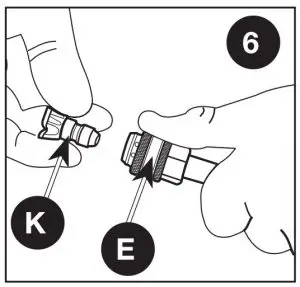
 WARNING: Flying object could cause risk of serious injury. Ensure nozzle is completely inserted in quick connect socket and quick connect collar is fully engaged (forward) before squeezing gun trigger.
WARNING: Flying object could cause risk of serious injury. Ensure nozzle is completely inserted in quick connect socket and quick connect collar is fully engaged (forward) before squeezing gun trigger.
How to APPLY chemicals/cleaning solvents (fIG. 7)

Applying chemicals or cleaning solvents is a low pressure operation. NOTE: Use only soaps and chemicals designed for pressure washer use. Do not use bleach.
To Apply Chemicals:
- Ensure detergent siphon hose (F, Figure 9) is attached to barbed fitting location near high pressure hose connection of pump as shown.
- Place other end of detergent siphon hose with filter on it into container holding chemical/cleaning solution. NOTE: For every 7 gallons of water pumped
- gallon of chemical/cleaning solution will be used.
- Install low pressure (black) nozzle into quick connect fitting of spray wand, see How To Use Spray Wand paragraph in this section.
- After use of chemicals, place detergent siphon hose into container of clean water and draw clean water through chemical injection system to rinse system thoroughly. If chemicals remain in the pump, it could be damaged. Pumps damaged due to chemical residue will not be covered under warranty.
NOTE: Chemicals and soaps will not siphon if the black soap nozzle is not installed on the spray wand.
Starting (fIG. 8–11)
 WARNING: To reduce the risk of injury, read the pressure washer instruction manual and the engine instruction manual before starting pressure washer.
WARNING: To reduce the risk of injury, read the pressure washer instruction manual and the engine instruction manual before starting pressure washer.
 DANGER: Risk of fluid injection and laceration. When using the high pressure setting, DO NOT allow the high pressure spray to come in contact with unprotected skin, eyes, or with any pets or animals. Serious injury will occur.
DANGER: Risk of fluid injection and laceration. When using the high pressure setting, DO NOT allow the high pressure spray to come in contact with unprotected skin, eyes, or with any pets or animals. Serious injury will occur.
- • Your washer operates at fluid pressures and velocities high enough to penetrate human and animal flesh, which could result in amputation or other serious injury. Leaks caused by loose fittings or worn or damaged hoses can result in injection injuries. DO NOT TREAT FLUID INJECTION AS A SIMPLE CUT! See a physician immediately!
 DANGER: Carbon Monoxide. Using an engine indoors can kill you in minutes. Engine exhaust contains high levels of carbon monoxide (CO), a poisonous gas you cannot see or smell. You may be breathing CO even if you do not smell engine exhaust.
DANGER: Carbon Monoxide. Using an engine indoors can kill you in minutes. Engine exhaust contains high levels of carbon monoxide (CO), a poisonous gas you cannot see or smell. You may be breathing CO even if you do not smell engine exhaust. - Breathing exhaust fumes will cause serious injury or death! Engine exhaust contains carbon monoxide, an odorless and deadly gas.
- Operate pressure washer in a well-ventilated area. Avoid enclosed areas such as garages, basements, etc.
- Never operate unit in or near a location occupied by humans or animals
 WARNING: Risk of Fire, Asphyxiation and Burn. Never fill fuel tank when engine is running or hot. Do not smoke when filling fuel tank.
WARNING: Risk of Fire, Asphyxiation and Burn. Never fill fuel tank when engine is running or hot. Do not smoke when filling fuel tank. - Never fill fuel tank completely. Fill tank to 1/2″ (12.7 mm) below bottom of filler neck to provide space for fuel expansion. Wipe any fuel spillage from engine and equipment before starting engine.
- DO NOT let hoses come in contact with very hot engine muffler during or immediately after use of your pressure washer. Damage to hoses from contact with hot engine surfaces will NOT be covered by warranty.
NOTICE: Risk of property damage. Never pull water supply hose to move pressure washer. This could damage hose and/or pump inlet - DO NOT use hot water, use cold water only.
- Never turn water supply off while pressure washer engine is running or damage to pump will result.
- DO NOT stop spraying water for more than two minutes at a time. Pump operates in bypass mode when spray gun trigger is not pressed. If pump is left in bypass mode for more than two minutes internal components of the pump can be damaged.
If you do not understand these precautions, please contact our customer service
department at www.simpsoncleaning.com
Prior to starting, refer to your engine manual for proper starting procedure.
- In a well ventilated outdoor area add fresh, high quality, unleaded gasoline with a pump octane rating of 86 or higher. Do not overfill. Wipe up spilled fuel before starting the engine. Refer to Engine Owner’s Manual for correct procedure

NOTICE: Use of fuels with greater than 10% ethanol are not approved for use in this product per EPA regulations and will damage the unit and void the warranty.. - Check engine oil level. Refer to Engine Owner’s Manual for correct procedure.
- Check pump oil level. The oil level should come to the dot in the middle of the sight glass. Refer to the Pump paragraph under Maintenance.
- Connect the water hose to the water source. Turn the water source on to remove all air from the hose. When a steady stream of water is present, turn the water source off.
- Verify the filter screen (O) is in water inlet of pump. NOTE: Convex side faces out.
- Connect water source (N) to pump inlet (J). NOTE: Water source must provide a minimum of 5 gallons per minute at 20 PSI.
- Connect high pressure hose (C) to pump outlet (I).

 WARNING: To reduce the possibility of contamination always protect against back flow when connected to a potable water system.
WARNING: To reduce the possibility of contamination always protect against back flow when connected to a potable water system. - Choose the correct nozzle for the job to be performed. See How To Use spray Wand instructions in this section. NOTE: If applying a chemical or cleaning solution, see How To Apply Chemicals/Cleaning Solvents instructions in this section.
- Turn water source on.
NOTICE: Risk of property damage. Failure to do so could cause damage to the pump. - Remove all air from the pump and high pressure hose by depressing trigger until a steady stream of water is present.
- Start engine. See Engine Owner’s Manual for correct procedure.
 WARNING: Risk of unsafe operation. If engine does not start after two pulls, squeeze trigger of gun to relieve pump pressure. Pull starter cord slowly until resistance is felt. Then pull cord rapidly to avoid kickback and prevent hand or arm injury.
WARNING: Risk of unsafe operation. If engine does not start after two pulls, squeeze trigger of gun to relieve pump pressure. Pull starter cord slowly until resistance is felt. Then pull cord rapidly to avoid kickback and prevent hand or arm injury.
Note: If the oil level in the engine is low, the engine will not start. If the engine does not start, check the oil level and add oil as needed. - Depress trigger on gun to start water flow.
 WARNING: Risk of unsafe operation. Stand on a stable surface and
WARNING: Risk of unsafe operation. Stand on a stable surface and
grip gun/spray wand firmly with both hands. Expect the gun to kick when triggered. 13. Release trigger to stop water flow.
 WARNING: Risk of injury from spray. Always engage the trigger lock (P) when gun is not in use. Failure to do so could cause accidental spraying.
WARNING: Risk of injury from spray. Always engage the trigger lock (P) when gun is not in use. Failure to do so could cause accidental spraying.
Shutting down
- After each use, if you have applied chemicals, place detergent siphon hose into container of clean water and draw clean water through chemical injection system to rinse system thoroughly.

- NOTICE: Risk of property damage. Failure to do so could cause damage to the pump.
Turn engine off. See Engine Owner’s Manual.
NOTICE: Risk of property damage. NEVER turn the water off with the engine running. - Turn water source off.
- Pull trigger on spray gun to relieve any water pressure in hose or spray gun.
NOTE: Failure to release system pressure will prevent removal of high pressure hose from spray gun or pump connection. - See Storage section in this manual for proper storage procedures.
Maintenance
 WARNING: Risk of burn hazard. When performing maintenance, you may be exposed to hot surfaces, water pressure or moving parts that can cause serious injury or death.
WARNING: Risk of burn hazard. When performing maintenance, you may be exposed to hot surfaces, water pressure or moving parts that can cause serious injury or death.
 WARNING: Risk of fire hazard. Always disconnect, spark plug wire, let the engine cool and release all water pressure before performing any maintenance or repair. The engine contains flammable fuel. Do not smoke or work near open flames while performing maintenance.
WARNING: Risk of fire hazard. Always disconnect, spark plug wire, let the engine cool and release all water pressure before performing any maintenance or repair. The engine contains flammable fuel. Do not smoke or work near open flames while performing maintenance.
To ensure efficient operation and longer life of your pressure washer, a routine maintenance schedule should be prepared and followed. If the pressure washer is used in unusual conditions, such as high-temperatures or dusty conditions, more frequent maintenance checks will be required.
Engine
Consult the Engine Owner’s Manual for the manufacturer’s recommendations for any and all maintenance. NOTE: The engine drain plug is located at the rear of the unit.
PUMP (fig. 12)
NOTE: The Pump was filled with oil at the factory. The preferred oil is SIMPSON® Premium Pump Crankcase Oil. If this oil is not available, an SAE 15W-40 oil may be used. Change the pump oil after the first 50 hours of operation and every 100 hours thereafter, or every 3 months.
To Check Oil
The oil level should come to the dot in the middle of the sight glass (AA).
How To Change Pump Oil
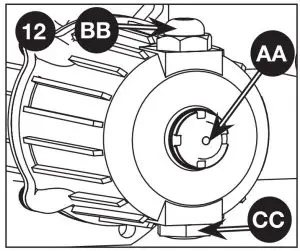
- Loosen pump oil fill plug (BB).
- Place a container under the pump oil drain plug (CC).
- Remove pump oil drain plug.
- After oil is drained, replace pump oil drain plug. Tighten securely.
- Refill pump using SIMPSON® Premium Pump Crankcase Oil. If this oil is not available, an SAE 15W-40 oil may be used.
- Replace pump oil fill plug and tighten securely.
If there is a problem with the pump contact us at www.simpsoncleaning.com
Connections
Connections on pressure washer hoses, gun and spray wand should be cleaned regularly and lubricated with light oil or lithium grease to prevent leakage and damage to the o-rings.
NOZZLE CLEANING (fig. 13)
If the nozzle becomes clogged with foreign materials, such as dirt, excessive pressure may develop. If the nozzle becomes partially clogged or restricted, the pump pressure will pulsate. Clean the nozzle immediately using the nozzle kit supplied and the following instructions:

- Shut off the pressure washer and turn off the water supply.
- Pull trigger on gun handle to relieve any water pressure.
- Disconnect the spray wand from the gun.
- Remove the high pressure nozzle (K) from the spray 13 K wand. Remove any obstructions with the nozzle cleaning tool provided and back flush with clean water.
- Direct water supply (N) into nozzle to back flush loosened particles for 30 seconds.
- Reassemble the nozzle to the wand.
- Reconnect spray wand to gun and turn on water supply.
- Start pressure washer and place spray wand into high pressure setting to test.
CLEAN THE WATER INLET FILTER (fIG. 8)
This screen filter should be checked periodically and cleaned if necessary.
- Remove filter by grasping end and removing it from water inlet of pump.
- Clean filter by flushing it with water on both sides.
- Re-insert filter into water inlet of pump.
NOTE: Convex side faces out.
NOTE: Do not operate the pressure washer without filter properly installed.
STORAGE
ENGINE
Consult the Engine Owner’s Manual for manufacturer’s recommendations for storage.
PUMP
The manufacturer recommends using SIMPSON® / POWERWASHER® Pump Guard or equivalent when storing the unit for more than 30 days and/or when freezing temperatures are expected. SIMPSON® / POWERWASHER® Pump Guard is environmentally friendly.
NOTE: Using pump guard helps provide proper lubrication to the internal seals of the pump regardless of temperature or environment.
NOTICE: Risk of property damage. Use only SIMPSON® / POWERWASHER® Pump Guard or equivalent. Other products could be corrosive and/or contain alcohol which may cause pump damage.
PRESSURE WASHER
- Drain all water from high pressure hose and wrap it onto hose wrap.
- Drain all water from the spray gun and wand by holding spray gun in a vertical position with nozzle end pointing down and squeezing trigger. Store in gun holder.
- Wrap up and secure detergent siphon hose so it is protected from damage
ACCESSORIES
 DANGER: Risk of fluid injection. When using replacement spray wands or guns with this pressure washer, DO NOT use a spray wand and/or spray gun/ wand combination that is shorter in length than what was provided with this pressure washer as measured from the nozzle end of the wand to the gun trigger.
DANGER: Risk of fluid injection. When using replacement spray wands or guns with this pressure washer, DO NOT use a spray wand and/or spray gun/ wand combination that is shorter in length than what was provided with this pressure washer as measured from the nozzle end of the wand to the gun trigger.
NOTICE: The use of any other accessory not recommended for use with this tool could be hazardous. Use only accessories rated equal to or greater than the rating of the pressure washer.
Service Information
Do not return this product to your retailer. Please contact our customer service department at www.simpsoncleaning.com.
LIMITED WARRANTY
The manufacturer of this product agrees to repair or replace designated parts that prove defective within the warranty period listed below at the manufacturer’s sole discretion. Specific limitations/extensions and exclusions apply.
This warranty covers defects in material and workmanship and not parts failure due to normal wear, depreciation, abuse, accidental damage, negligence, improper use, maintenance, water quality or storage. To make a claim under the terms of the warranty, all parts said to be defective must be retained and available for return upon request to a designated Warranty Service Center for warranty inspection. The judgments and decisions of the manufacturer concerning the validity of warranty claims are final.
These warranties pass through to the end user and are non-transferable. As a factory authorized and trained Warranty Service Center, the factory will honor the terms of all component warranties and satisfy claims of the appropriate warranty provisions. Normal wear items include, but are not limited to, valves and seals, which are not covered by this warranty.
This warranty replaces all other warranties, express or implied, including without limitation any warranties of merchantability or fitness for a particular purpose and all such warranties are hereby disclaimed and excluded by the manufacturer. The manufacturer’s warranty obligation is limited to repair and replacement of defective products as provided herein and the manufacturer shall not be liable for any further loss, damages, or expenses – including damages from shipping, accident, abuse, acts of God, misuse, or neglect. Neither is damage from repairs using parts not purchased from the manufacturer or alterations performed by non-factory authorized personnel. Failure to install and operate equipment according to the guidelines put forth in the instruction manual shall void warranty.
This warranty does not cover the following: machines used for rental purposes, damage resulting from shipping (claims must be filed with freighter), accident, abuse, act of God, misuse, or neglect. Neither is damage from repairs or alterations performed by non-factory authorized personnel or failure to install and operate equipment according to the guidelines put forth in the instruction manual. The manufacturer will not be liable to any persons for consequential damage, for personal injury, or for commercial loss.
Warranty does not apply to failures due to:
- Freight damage
- Damage due to chemical deterioration, scale build up, rust, corrosion or thermal expansion
- Freeze damage
- Damage caused by parts or accessories not obtained from an authorized dealer or not approved by the manufacturer.
- Normal wear of moving parts or components affected by moving parts.
Engine
Covered by engine manufacturer warranty. See engine manual.
HIGH pressure pump (Defects in Material and workmanship)
Covered by pump manufacturer warranty.,
OTHER COMPONENTS (defects in material and workmanship)
Includes nozzles, hoses, spray guns, wands Ninety (90) days from date of purchase.
Trouble shooting guide
| OPERATIONAL ISSUE | POSSIBLE CAUSE | SOLUTION |
| Engine will not start (see Engine Owner’s Manual for
further engine troubleshooting) |
No fuel | Add fresh fuel |
| Pressure builds up after two pulls on the recoil starter or after initial use | Squeeze gun trigger to relieve pressure | |
| Choke lever in the “No Choke” position | Move choke to the “Choke” position | |
| Spark plug wire not attached | Attach spark plug wire | |
| Engine switch in OFF position. | Place engine switch in ON position. | |
| Choke lever in the “Choke” position on a “hot” engine or an engine that has been exposed to thermal heat for a long period of time. | Move choke to the “No Choke”position. | |
| No or low pressure (initial use) | Spray wand not in high pressure | See How to Use Spray Wand instructions in the Operation Section |
| Low water supply | Water supply must be at least 5 gpm @ 20 PSI | |
| Leak at high pressure hose fitting | Repair leak. Apply sealant tape if necessary | |
| Nozzle obstructed | See Nozzle Cleaning instructions in the Maintenance section | |
| Water filter screen clogged | Remove and clean filter. See Cleaning Water Inlet Filter paragraph in the Maintenance section for the correct procedure |
| OPERATIONAL ISSUE | POSSIBLE CAUSE | SOLUTION |
| Air in hose | Turn off the engine, then the water source. Disconnect the water source from the pump inlet and turn the water source on to remove all air from the hose. When there is a steady stream of water present, turn water source off. Re-connect water source to pump inlet and turn on water source. Squeeze trigger to remove remaining air |
|
| Choke in the “Choke” position | Move choke to the “No Choke” position | |
| High pressure hose is too long | Use high pressure hose under
100 feet (30 m) |
|
| Will not draw chemicals | Spray wand not in low pressure | See How to Use Spray Wand paragraph in the Operation Section |
| Chemical filter clogged | Clean filter | |
| Chemical screen not in cleaning solution | Make sure end of detergent siphon hose is fully submerged into cleaning solution | |
| Chemical too thick | Dilute chemical. Chemical should be the same consistency as water | |
| Will not draw chemicals | Pressure hose is too long | Lengthen water supply hose instead of high pressure hose |
| Chemical build up in chemical injector | Please contact our customer service department at www.simpsoncleaning.com | |
| No or low pressure
(after period of normal use) |
Worn seal or packing | Please contact our customer service department at www.simpsoncleaning.com |
| Worn or obstructed valves | Please contact our customer service department at | |
| Worn unloader piston | Please contact our customer
service department at www.simpsoncleaning.com |
|
| Water leaking at gun/spray wand
connection |
Worn or torn o-ring | Check and replace |
| Loose hose connection | Tighten |
| Water leaking at pump | Loose connections | Tighten |
| Piston packings worn | Please contact our customer service department at www.simpsoncleaning.com | |
| Worn or torn o-ring | Please contact our customer service department at www.simpsoncleaning.com | |
| Pump head or tubes damaged from freezing | Please contact our customer service department at www.simpsoncleaning.com | |
| Pump pulsates | Nozzle obstructed | See Nozzle Cleaning paragraph in the Maintenance section for the correct procedure |
| Oil leaking at pump | Oil seals worn. | Please contact our customer service department at www.simpsoncleaning.com |
| Loose drain plug | Tighten | |
| Worn drain plug o-ring | Check and replace | |
| Worn fill plug o-ring | Check and replace | |
| Pump overfilled | Check for correct amount | |
| Incorrect oil used | Drain and fill with correct amount and type of oil | |
| Vent plug is clogged | Clean vent plug; blow air through it to remove any blockage. If problem persists, replace plug | |
| Air filter filled with oil | Clean and/or replace filter element. Refer to Engine Owner’s Manual for correct procedure. |
Internet Address: www.simpsoncleaning.com
Warranty Registration via Internet
Copyright. All Rights Reserved
DOWNLOAD REESOURCES
- SIMPSON Premium Pressure Washer [pdf] Instruction Manual Premium Pressure Washer
- Read more: https://manuals.plus/simpson/premium-pressure-washer-manual#ixzz7e88mu4D7
FAQ’S
How much pressure can the Simpson pressure washer produce?
The Simpson pressure washer can produce up to 1,800 PSI and 3.8 GPM.
How long does it take to assemble a Simpson pressure washer?
It takes about 15 minutes to assemble a Simpson pressure washer.
What is the difference between the Simpson pressure washers?
The Simpson pressure washers are all the same except for the engine. The engine is what makes the difference in torque, PSI and GPM.
How do I know which engine is best for me?
You should go with the higher engine if you have a lot of tough jobs to do or you have a large area to cover. The lower engines are better for small jobs and for people who don’t need a lot of power.
What kind of fuel should I use in my pressure washer?
You should use only unleaded gasoline with an octane rating of 87 or higher, ethanol-free gasohol or methanol in your Simpson pressure washer. Using gasoline with less than 87 octane, or using fuel containing methanol or ethanol may cause damage to your unit and will void your warranty.
How do I start my Simpson pressure washer?
To start your Simpson pressure washer, first pull out the choke knob on top of the engine and pull it out until it stops, then turn on the gas valve located at the bottom of your unit by pulling it out until it stops, then slowly push it back in until you hear a click. Pull out the choke knob again and push it in until you hear another click and pull out again until you hear another click, then push in again until you hear another click. Now pull out once more until you hear another click and push in again until you hear another click. Now pull out one more time until you hear another click and push in again until you hear another click. Now pull out one more time until you hear another click and push in again until you hear another click, now pull out one more time until you hear another click and push in again until you hear another click, now pull out one more time until you hear another click and push in again until you hear another click, now pull out one more time until you hear another click and push in again until you here a loud pop sound which means that your engine is running at full speed now just give it some gas by pulling on the throttle trigger located on top of your unit next to the choke knob while holding down on the safety lock button located on top of your unit with your other hand then release both buttons when ready to start cleaning. It’s that easy! Just remember that if there is no loud pop sound after releasing both buttons then something may be wrong so check all connections first before trying to start it again. If after checking all connections.
Can I use hot water with my pressure washer?
No, only use the cold-water hose bib or spigot on your house with the pressure washer. Cold water helps to cool the pump. Hot water can damage a cold-water pressure washer pump.
Does Simpson pressure washer have detergent tank?
That would be the end of an expensive hose. The Simpson pressure washer also comes with five clip on spray tips of varying degrees, plus it has a detergent tank.
Can dish soap be used in pressure washer?
Dish soap is very similar to most pressure washer detergents, so it can be used in a pressure washer. Not only that, but it also increases the grime-cutting power of your pressure washer. After a thorough cleaning, the surface that you’re spraying will look as good as new.
Should you pressure wash windows?
Don’t pressure wash windows! The high pressure can break them, giving you a major headache and an expensive window to replace.
What happens if you pressure wash your foot?
The strong spray from a pressure washer can cause serious wounds that might first appear minor. Wounds that appear minor can cause a person to delay treatment, increasing risk for infection, disability or amputation.
How hot do hot water pressure washers get?
Hot water pressure washers use high pressure and high temperatures to deal with stubborn messes. The water in these machines can reach temperatures of up to 200 degrees Fahrenheit, and evaporate spills that cold water can’t handle.
SIMPSON Premium Pressure Washer
www://simpsoncleaning.com/
SIMPSON pressure washer User Manual

TROUBLE SHOOTING GUIDE
| OPERATIONAL ISSUE | POSSIBLE CAUSE | SOLUTION |
| Engine will not start (see Engine Owner’s Manuall for further engine troubleshooting) | No fuel. | Add fresh fuel. |
| Pressure builds up after two pulls on the recoil starter or after initial use | Squeeze gun trigger to relieve pressure | |
| Choke lever in the “No Choke” position | Move choke to the “Choke” position | |
| Spark plug wire not attached. | Attach spark plug wire. | |
| Engine switch in OFF position | Place engine switch in ON position | |
| Choke lever in the “Choke” position on a “hot” engine or an engine that has been exposed to thermal heat for a long period of time | Move choke to the “No Choke” position |
LIMITED WARRANTY
90 DAY LIMITED WARRANTY ON PRODUCT COMPONENTS EXCLUDING PUMP
SIMPSON® warrants to the original purchaser that the wheels, gun, hose, wand, spray nozzle(s), surface cleaner and other components of the SIMPSON® pressure washer covered under this warranty are free from defects in material and workmanship for 90 days from the date of purchase.
TW0 YEAR LIMITED WARRANTY ON PUMP AND FRAME
SIMPSON® warrants to the original purchaser that the pump of the SIMPSON® pressure washer covered under this warranty is free from manufacturer’s defects in material and workmanship for two years from the date of purchase. The two year limited warranty applies to the pump only.
SIMPSON® will repair or replace, at SIMPSON®’s option, products or comp onents which have failed within the above warranty periods. Service will be scheduled according to the normal work flow and business hours at the service center location, and the availability of replacement parts. All decisions of SIMPSON® with regard to this limited warranty shall be final. This warranty gives you specific legal rights, and you may also have other rights which vary from state to state.
ENGINE WARRANTY
The engine, emission control system and related components are covered under the terms and conditions outlined by the engine manufacturer’s warranty and are the sole responsibility of the engine manufacturer. A copy of the engine manufacturer’s warranty has been provided to you with your SIMPSON® pressure washer. Please consult the engine manufacturer’s warranty to process a claim or obtain service to the engine, emission control system or related components.
RESPONSIBILITY OF ORIGINAL PURCHASER (INITIAL USER):
- To process a warranty claim on your SIMPSON® pressure washer, report the concern to 1-877-362-4271 or [email protected] for authorization and direction to the nearest authorized service center in your area.
- Retain original cash register sales receipt as proof of purchase for warranty work.
- Use reasonable care in the operation and maintenance of the product as described
in the Owners Manual(s).
THIS WARRANTY DOES NOT COVER:
- Merchandise sold as reconditioned, used as rental equipment, or floor or display models.
- Merchandise that has become damaged or inoperative because of ordinary wear, misuse, cold, heat, rain, excessive humidity, water quality, freeze damage, use
of improper chemicals, negligence, accident, failure to operate the product in accordance with the instructions provided in the Owners Manual(s) supplied with
the product, improper maintenance, the use of accessories or attachments not recommended by SIMPSON® , or unauthorized repair or alterations. - Repair and transportation costs of merchandise determined not to be defective.
- Damage due to chemical deterioration, scale build up, rust, corrosion or thermal expansion
- Costs associated with assembly, required oil, adjustments or other installation and start-up costs.
- Expendable parts or accessories supplied with the product which are expected to become inoperative or unusable after a reasonable period of use, including but not limited to springs, nozzles, orings, washers, and similar accessories.
- Merchandise sold by SIMPSON® which has been manufactured by and identified as the product of another company, such as gasoline engines. The product manufacturer’s warranty, if any, will apply.
- ANY INCIDENTAL, INDIRECT OR CONSEQUENTIAL LOSS, DAMAGE, OR EXPENSE THAT MAY RESULT FROM ANY DEFECT, FAILURE OR MALFUNCTION OF THE PRODUCT IS NOT COVERED BY THIS WARRANTY. Some states do not allow the exclusion or limitation of incidental or consequential damages, so the above limitation or exclusion may not apply to you.
- IMPLIED WARRANTIES, INCLUDING THOSE OF MERCHANTABILITY OR FITNESS FOR A PARTICULAR PURPOSE, ARE LIMITED TO ONE YEAR FROM THE DATE OF ORIGINAL PURCHASE. Some states do not allow limitations on how long an implied warranty lasts, so the above limitations may not apply to you.
SIMPSON 13SIE-170 Electric Pressure Washer
EASY INSTALLATION
WARNING: CAREFULLY READ THE OPERATOR’S INSTRUCTIONS BEFORE USING THE PRESSURE WASHER FOR THE FIRST TIME.
- WITH THE HANDLE ORIENTED AS SHOWN, ALIGN GROOVES IN THE CARRY HANDLE (P) WITH RAILS ON TOP OF PRESSURE WASHER AND SLIDE INTO PLACE. PUSH AS SHOWN TO FURTHER LOCK CARRY HANDLE INTO PLACE.

- REMOVE AND DISCARD THE SHIPPING PLUG (L) FROM THE OUTLET (K) ON THE FRONT OF THE MACHINE.
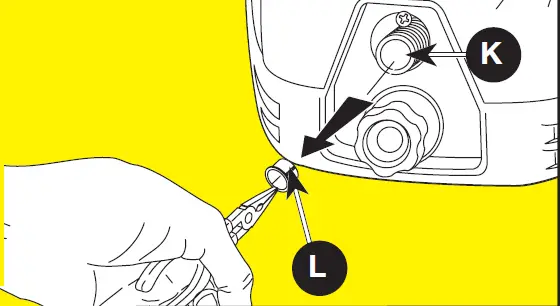
- CONNECT THE HIGH PRESSURE HOSE (E) TO THE MACHINE OUTLET (K).
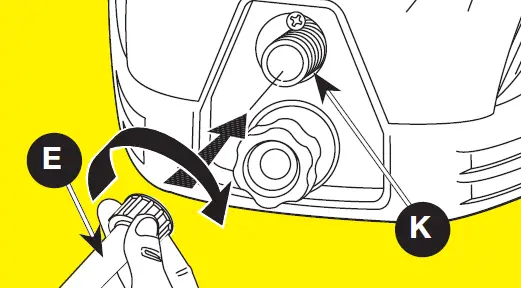
- CONNECT THE GARDEN HOSE (Y) TO THE CONNECTOR (D) ON THE FRONT OF THE MACHINE.
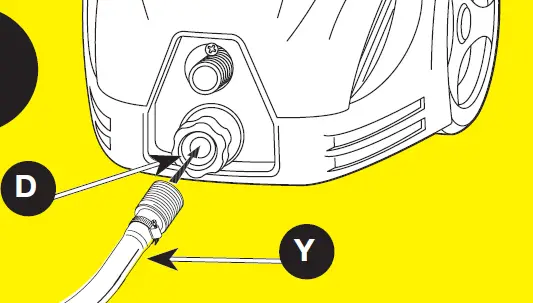
- Insert the spray wand (B) into the gun (A). Twist Spray wand 90° to securely lock in place.

- Pull the quick-connect coupler back and insert a nozzle.
Release the quick-connect coupler and twist the nozzle to make sure it is secure in the coupler.
- TURN INCOMING WATER ON.
NOTE: USE COLD WATER ONLY.
- PLUG GFCI (C) INTO THE POWER RECEPTACLE. FIRMLY PRESS AND RELEASE THE TEST BUTTON (X), THEN PRESS AND RELEASE THE RESET BUTTON (W). THE LIGHT ON THE GFCI SHOULD
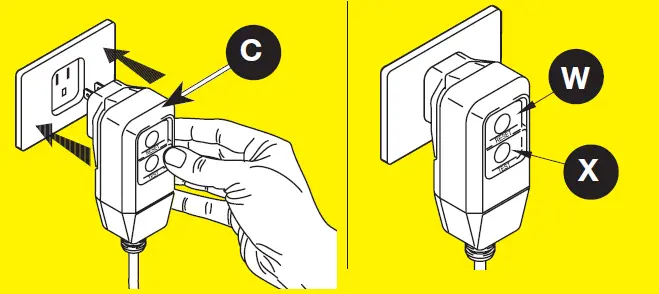
- SQUEEZE AND HOLD TRIGGER UNTIL WATER FLOW IS STEADY. RELEASE THE TRIGGER.

- Turn switch to ON position (I) AND SQUEEZE TRIGGER TO START MOTOR AND WATER FLOW. Note: motor only runs when trigger is depressed and water is spraying.
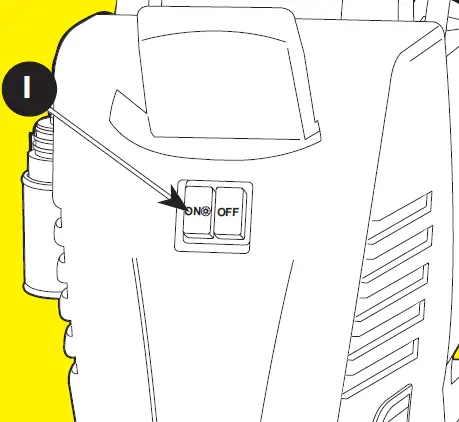
SAFETY GUIDELINES
DEFINITIONS
This manual contains information that is important for you to know and understand. This information relates to protecting YOUR SAFETY and PREVENTING EQUIPMENT PROBLEMS. To help you recognize this information, we use the symbols below. Please read the manual and pay attention to these symbols.
DANGER: Indicates an imminently hazardous situation which, if not avoided, will result in death or serious injury.
WARNING: Indicates a potentially hazardous situation which, if not avoided, could result in death or serious injury.
CAUTION: Indicates a potentially hazardous situation which, if not avoided, may result in minor or moderate injury.
NOTICE: Indicates a practice not related to personal injury which, if not avoided, may result in property damage.
CONSUMER SAFETY INFORMATION
WARNING: This product contains chemicals known to the State of California to cause cancer, and birth defects or other reproductive harm. In addition, some cleaning products and dust contain chemicals know to the State of California to cause cancer, and birth defects or other reproductive harm. Wash hands after handling.
IMPORTANT SAFETY INSTRUCTIONS
WARNING: Please read this entire manual before attempting to assem-ble, operate or install the product. If you have any questions regard-ing the product, please contact our customer service department at www.simpsoncleaning.com.
WARNING: This unit was designed for specific applications. It should not be modified and/or used for any application other than that which it was designed.
NOTICE: Always store your pressure washer in a location where the temperature will not fall below 40 °F (4 °C). freeze damage is not covered by the warranty.
READ AND SAVE THESE INSTRUCTIONS
WARNING: When using this product basic precautions should always be followed, including the following:
- Read all the instructions before using the product.
- To reduce the risk of injury, do not operate near children or animals.
- Know how to stop the product and bleed pressures quickly. Be thoroughly familiar with the controls.
- Stay alert – watch what you are doing.
- Do not operate the product when fatigued or under the influence of alcohol or drugs.
- Keep the operating area clear of all persons.
- Do not overreach or stand on unstable support. Keep good footing and balance at all times.
- Follow the maintenance instructions specified in the manual.
- This product is provided with a Ground Fault Circuit Interrupter built into the power cord plug. If replacement of the plug or cord is needed, use only identical replacement parts.
- Do not touch plug or outlet with wet hands.
- Avoid accidental starts. Move switch on unit to OFF position before connecting or disconnecting cord to electrical outlets.
- Water spray must never be directed towards any electric wiring or directly towards the pressure washer machine itself or fatal electric shock may occur.
- Never carry your pressure washer by the cord. Do not pull on the cord to disconnect from the outlet.
- To prevent damage, the cord should not be crushed, placed next to sharp objects or near a heat source.
- Check power cords before using. Damaged cords can reduce performance of pressure washer or cause a fatal electrical shock.
- The narrow pin point stream is very powerful. It is not recommended for use on painted surfaces, wood surfaces or items attached with an adhesive backing.
- Keep operating area clear of all persons and ani mals.
- Always use both hands when operating pressure washer to maintain complete control of the wand.
- Do not touch nozzle or water spray while operating. Never place hands in front of nozzle.
- Wear safety goggles while operating. Wear protective clothing and footwear to protect against accidental spraying.
- Disconnect power plug from the outlet when not in use and prior to the detaching of the high pressure hose.
- Never tie knots or kink the high pressure hose as da mage could result. Inspect the high-pressure hose regularly. Replace the hose immediately if it is damaged, worn or shows any signs of cracks, bubbles, pinholes, or other leakage. Never grasp a high-pressure hose that is leaking or damaged.
- Do not operate or store this product in temperatures below 40 °F (4 °C). Freeze damage is not covered by the warranty.
- Carefully observe all chemical instructions and warnings before using. Use only approved pressure washer cleaners. Do not use bleach, chlorine, or any cleaners containing acids. Always follow manufacturer’s label recommendations for proper use of cleaners. Always protect eyes, skin and respiratory system from cleaners.
- The pressure washer should not be used in areas where gas vapors may be present. An electric spark could cause an explosion or fire.
- To minimize the amount of water getting into the pressure washer, the unit should be placed as far as possible from the cleaning site during operation.
- To prevent accidental discharge, the spray gun should be secured by locking the trigger when not in use.
- To allow free air circulation, the pressure washer should NOT be covered during operation.
- Never touch, grasp or attempt to cover a pinhole or similar water leak on the high-pressure hose. The stream of water IS under high pressure and WILL penetrate skin.
- Use only hoses and accessories rated for pressure higher than your pressure washer’s psi. Never use with any other manufacturer’s accessories or components.
- Never defeat the safety features of this product.
- Do not op er ate machine with missing, broken or un au tho rized parts.
- Never spray flammable liquids or use a pressure washer in areas containing combustible dust, liquid, or vapors.
WARNING: Risk of injection or injury. Do not direct the discharge stream at persons.
SAVE THESE INSTRUCTIONS
SAFETY FEATURES
AUTOMATIC TOTAL STOP®
The pressure washer is equipped with a stop device that will sense when the trigger on the gun is released. It will open the power circuit to the motor and cause the pressure washer to stop.
WARNING: If Automatic Total Stop fails to operate, DO NOT USE THE MACHINE. Contact our customer service department. Further use will damage the machine and/or cause personal injury.
WARNING: The pressure washer is also equipped with a main power ON/OFF switch located on the unit. It should always be moved to the OFF position when the pressure washer is not being used to prevent possible injury or damage.
MOTOR OVERLOAD
The electric motor in this pressure washer is equipped with an overload protection device which will automatically shut off the motor in the event the motor draws excessive current or overheats. The device will automatically reset itself and resume normal operation after a short period of time.
GROUND-FAULT CIRCUIT INTERRUPTER PROTECTION
This pressure washer is provided with a Ground-Fault Circuit-Interrupter (GFCI) built into the plug of the power supply cord. This device provides additional protection from the risk of electric shock. Should replacement of the plug or cord become necessary, use only identical replacement parts that include GFCI protection.
SERVICING A DOUBLE-INSULATED APPLIANCE
 In a double-insulated product, two systems of insulation are provided instead of grounding.
In a double-insulated product, two systems of insulation are provided instead of grounding.
No grounding means is provided on a double-insulated product, nor should a means for grounding be added to the pressure washer.
Servicing a double-insulated product requires extreme care and knowledge of the system, and should be done only by qualified service personnel. Replacement parts for a double-insulated product must be identical to the parts they replace.
A double-insulated product is marked with the words “DOUBLE-INSULATION” or “DOUBLE-INSULATED”. The symbol above may also be marked on the product.
POWER SUPPLY AND ELECTRICAL INFO GROUND-FAULT CIRCUIT INTERRUPTER PROTECTION
The pressure washer is factory-equipped with an electrical cord and a Ground Fault Circuit Interrupter (GFCI) power plug. This cord should only be connected to an electrical outlet installed in accordance with local safety regulations.
NOTE: The power supply must be 120 V, 60 Hz and a minimum 15 amp dedicated circuit.
- Inspect cord before using. Do not use if cord is damaged.
- Keep all connections dry and off the ground.
- Do not touch plug with wet hands.
- The pressure washer is provided with a ground fault circuit interrupter built into the power plug.
If replacement of the plug or cord is needed, use only identical replacement parts. Contact customer service for proper replacement parts.
WARNING: Test GFCI before each use. DO NOT use pressure washer if test below fails.
GFCI Test Procedures:
- Plug GFCI into power receptacle.
Indicator light should illuminate. - Press test button (X). Light should turn off.
- Press reset button (W) for use. Indicator light should illuminate.

Do not use if above test fails.
NOTE: The GFCI must be reset each time the pressure washer is connected to an electrical outlet. Reset by simply pushing the reset button on the GFCI power plug.
EXTENSION CORDS
Use only extension cords that are intended for outdoor use. These extension cords are identified by a marking “Acceptable for use with outdoor appliances: store indoors while not in use”. Use only extension cords having an electrical rating not less than the rating of the product. Do not use damaged extension cords. Examine extension cord before using and replace if damaged. Do not abuse extension cord and do not yank on any cord to disconnect.
Keep cord away from heat and sharp edges. Always disconnect the extension cord from the receptacle before disconnecting the product from the extension cord.
When using an extension cord, observe the specification below:
WARNING: To reduce the risk of electrocution, keep all connections dry and off the ground. Do not touch plug with wet hands.
SAVE THESE INSTRUCTIONS
GET TO KNOW THE PRESSURE WASHER
NOTE: Photographs and line drawings used in this manual are for reference only and do not represent a specific model.
Compare the illustrations with your unit to familiarize yourself with the location of various controls and adjustments. Save this manual for future reference.
A. Spray Gun
B. Pro-Style Spray Wand
C. GFCI
D. Garden Hose Connector
(factory installed)
E. High-Pressure Hose
F. Safety Lock
G. Motor and Pump in Case
H. Power Supply Cord with GFCI
I. ON/OFF Switch
J. On-board Detergent Tank
K. High Pressure Outlet (metal)
L. Shipping Plug
M. Water Inlet (plastic)
N. On-Board Accessory
Storage Holsters
O. Water Inlet Filter Screen [factory installed inside water inlet (M)]
P. Carry Handle
Q. Cord Storage Location
R. Turbo Spray Nozzle
S. Quick Connect Spray Nozzles
T. Turbo Nozzle Storage Holster
U. Quick Connect Nozzle Storage
V. Hose Storage Location
ASSEMBLY INSTRUCTIONS
- Locate and remove all loose parts from the carton.
- With handle oriented as shown, align grooves in carry handle (P) with rails on top of pressure washer and slide into place.
- Push as shown to further lock carry handle into place.

- Remove and discard the shipping plug (L) from the outlet (K) on the front of the machine.

OPERATING INSTRUCTIONS
PRESSURE WASHER TERMINOLOGY
PSI: Pounds per Square Inch. The unit of measure for water pressure. Also used for air pressure, hydraulic pressure, etc.
GPM: Gallons Per Minute. The unit of measure for the flow rate of water.
CU: Cleaning Units. GPM multiplied by PSI. GPM x PSI = CU
Detergent Injection System: Mixes cleaners or cleaning solvents with the water to improve cleaning effectiveness.
Water Supply: All pressure washers must have a source of water . The minimum requirements for a water supply are 20 psi and 5 gallons per minute. If your water source is a well, the garden hose length can only be 30 ft. (9 m) max.
WARNING: T o reduce the possibility of contamination always protect against backflow when connected to a potable water system.
DANGER: Risk of fluid injection and laceration. When using the high-pressure setting, DO NOT allow the high-pressure spray to come in contact with unprotected skin, eyes, or with any pets or animals. Serious injury will occur.
- Your washer operates at fluid pressures and velocities high enough to penetrate human and animal flesh, which could result in amputation or other serious injury. Leaks caused by loose fittings or worn or damaged hoses can result in injection injuries. DO NOT TREAT FLUID INJECTION AS A SIMPLE CUT! See a physician immediately!
Pressure Washer Operating Features
How To Use Spray Wand
Refer to the following chart to choose the correct nozzle for the job to be performed.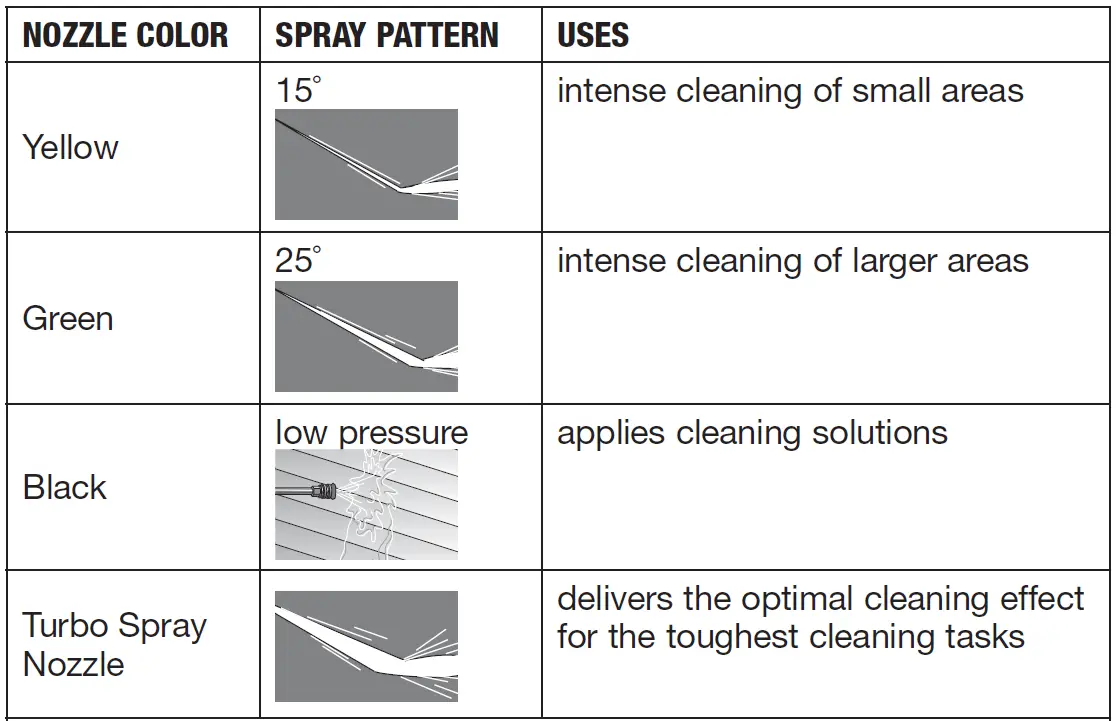
NOTE: The pressure of the spray on the surface you are cleaning increases as you move the wand closer to the surface.
NOTICE: The high pressure spray from your pressure washer is capable of causing damage to surfaces such as wood, glass, automobile paint, auto striping and trim, and delicate objects such as flowers and shrubs. Before spraying, check the item to be cleaned to assure yourself that it is strong enough to resist damage from the force of the spray.
CHANGING NOZZLES ON SPRAY WAND (FIG. 4)
DANGER: Risk of fluid injection. Do not direct discharge stream toward persons, unprotected skin, eyes or any pets or animals. Serious injury will occur.
WARNING: Flying objects could cause risk of serious injury. Do not attempt to change nozzles while pressure washer is running. Turn pressure washer off before changing nozzles.
- Pull quick-connect coupler back and insert nozzle (S).
- Release quick-connect coupler and twist nozzle to make sure it is secure in coupler.
 WARNING: Flying object could cause risk of serious injury. Ensure nozzle is completely inserted in quick-connect socket and quick-connect snap ring is fully engaged (forward) before squeezing gun trigger
WARNING: Flying object could cause risk of serious injury. Ensure nozzle is completely inserted in quick-connect socket and quick-connect snap ring is fully engaged (forward) before squeezing gun trigger
TURBO SPRAY NOZZLE (FIG. 5)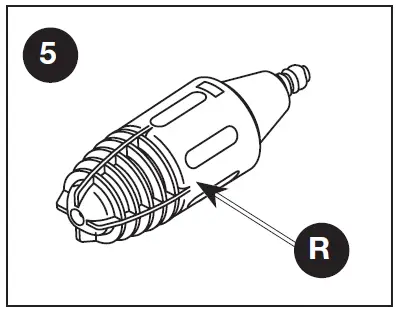
CAUTION: Do not attempt to move the nozzle to adjust pressure. The turbo nozzle is NOT adjustable.
The high pressure turbo nozzle (R) is intended for maximum cleaning effect. Keep the spray wand a minimum of 6–8 in (15–20 cm) away from the cleaning surface at all times.
USING DETERGENT (FIG. 6–7)
NOTICE: Use only approved pressure washer cleaners. Do not use bleach, chlorine, or any cleaners containing acids.
NOTICE: Fill and flush the detergent tank with clear water after use.
- Insert the spray wand (B) into the gun (A) by pushing firmly and simultaneously twisting a 1/4 of a turn until locked into place.
- Remove the tank cap (Z) present on the back of the machine.
- Fill the tank (J) with suitable cleaning solution.
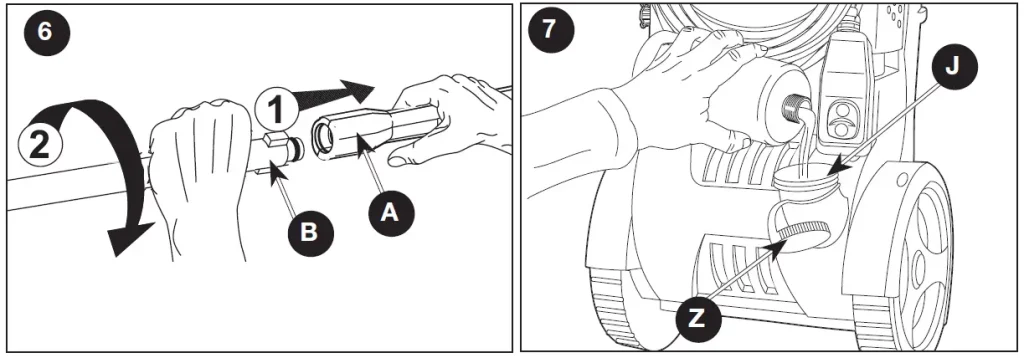
- Install low pressure (black) nozzle into quick connect fitting of spray wand, see How To Use Spray Wand paragraph in this section.
NOTE: Detergent will not siphon when the spray wand is equipped with the Yellow, Green, or Turbo Nozzles. The Low Pressure BLACK Nozzle must be used to dispense detergent - Squeeze the trigger and the detergent will automatically be mixed with the water and dispensed from the nozzle.
- When you have completed the use of detergent, Fill and flush the detergent tank with clear water after use. See Storage for correct procedure.
- See Storage section in this manual for proper shutdown and storage procedures
CLEANING TECHNIQUES
When cleaning with the pressure washer, some cleaning tasks can be solved with water alone, but for most tasks it is advantageous to use a detergent. A detergent ensures a quick soaking of the dirt allowing the high pressure water to penetrate and remove the dirt more effectively.
APPLICATION OF DETERGENT
CAUTION: Avoid working on hot surfaces or in direct sunlight to minimize the chance of the soap damaging painted surfaces.
CAUTION: Damage may occur to painted surface if soap is allowed to dry on the surface. Wash and rinse a small section at a time.
- Apply the solution to a DRY work surface.
NOTE: WETTING THE SURFACE FIRST IS NOT RECOMMENDED, AS IT DILUTES THE DETERGENT AND REDUCES ITS CLEANING ABILITY.
On a vertical surface, apply soap horizontally from side to side starting from the bottom to avoid streaking. - Allow detergent to remain on the surface for a short time before rinsing.
- Rinse with clean water under high pressure. On a vertical surface, first rinse from the bottom up, then rinse from the top down. Hold nozzle 6–8 in. (15–20 cm) from the work surface at a 45° angle using the flat spray as a peeling tool rather than a scrub brush.
NOTE: Ensure that the detergent injection system is completely clean prior to switching from one detergent to another. starting (Fig. 8–14)
DANGER: Risk of injury from spray. Always engage the trigger lock when gun is not in use. Failure to do so could cause accidental spraying.
WARNING: Risk of Injury. Do not direct discharge stream at self or others.
WARNING: Risk of unsafe operation. Stand on a stable surface and grip gun/spray wand firmly with both hands.
- Connect the high pressure hose (E) to the machine outlet (K). Ensure the threads are aligned properly and the connection is secure.

- Connect the garden hose (Y) to the connector (D) on the front of the machine. Before connecting, run water through the garden hose (not supplied) to flush out any foreign matter.
NOTE: If your water source is a well, the garden hose length can only be 30 ft. (9 m) maximum. - Insert the spray wand (B) into the gun (A) by pushing firmly and simultaneously twisting a 1/4 of a turn until locked into place.
WARNING: If the wand is not securely locked into place, it could be ejected under high pressure during operation, possibly causing injury or damage. - Turn incoming water on and fully open valve to insure maximum water flow to machine.

- Plug GFCI (C) into power receptacle. Firmly press and release the TEST button (X), then press and release the RESET button (W). The light on the GFCI should be illuminated.

- Ensure the gun safety is unlocked and squeeze the trigger until the air has escaped and a steady flow of low pressure water is coming from the nozzle.
NOTE: The power supply must be 120 V, 60 Hz and a minimum 15 amp dedicated circuit. - Turn switch to ON position (I). Note that the motor will momentarily start then stop.
- Squeeze the trigger to start motor and begin pressure washing.
NOTE: The motor only runs when the gun trigger is depressed and water is spraying.
SHUTTING DOWN
See Storage section in this manual for proper shutdown and storage procedures.
MAINTENANCE
Risk of burn hazard. When perfrming maintenance, you may be exposed to hot surfaces, water pressure or moving parts that can cause serious injury or death.
To ensure efficient operation and longer life of your pressure washer , a routine maintenance schedule should be prepared and followed. If the pressure washer is used in unusual conditions, such as high-temperatures or dusty conditions, more frequent maintenance checks will be required.
CONNECTIONS
Connections on pressure washer hoses, gun and spray wand should be cleaned regularly and lubricated with light oil or lithium grease to prevent leakage and damage to the o-rings.
NOZZLE
The nozzles should be cleaned regularly.
Clogging of the nozzle causes diminished performance and the pump pressure to be too high and cleaning is immediately required.
- Remove the wand from the gun.
- Clear the nozzle by forcing a stiff wire or straightened out paper clip (small size) through the center hole of each nozzle.
- Backflush the nozzle with water from both ends.
- Reconnect the wand to the gun.
Restart the pressure washer and depress the trigger on the spray gun.
LUBRICATION
The pressure washer is designed with a permanent lubrication system. Conventional oil checks and changes are not necessary.
NOTE: In case of oil leakage, contact our customer service department at www.simpsoncleaning.com. A SMALL AMOUNT OF OIL LEAKAGE IS NORMAL.
WATER SCREEN FILTER
The pressure washer is equipped with a water inlet screen filter to protect the pump. Never operate the pressure washer without the screen filter in place.
CAUTION: If the screen filter is not kept clean, the flow of water to the pressure washer will be restricted and the pump may be damaged.
- To clean the inlet water screen filter, remove garden hose connector (D) and remove the screen filter from the inlet.
- Flush screen filter with warm water to clean.
- Replace screen filter, and garden hose connector immediately to prevent any foreign matter from entering the pump.
CAUTION: Do not damage the screen filter, while removing or cleaning. Any foreign particles entering the pump may damage the pump.
COOLING SYSTEM
The air vents, located in and around the pressure washer, must be kept clean and free of any obstructions to ensure proper air cooling of the motor during operation.
WARNING: Prevent water from penetrating the vents of the pressure washer to minimize the risk of damage to the machine and to reduce the risk of shock to the operator.
Storage
CAUTION: Prior to moving the unit, always disconnect the garden hose via the garden hose connector.
CAUTION: Always store your pressure washer in a location where the tem-perature will not fall below 40 °F (4 °C). The pump in this machine is susceptible to permanent damage if frozen. FREEZE DAMAGE IS NOT COVERED BY THE WARRANTY.
END-OF-USE AND WINTER STORAGE INSTRUCTIONS
- When finished using the pressure washer, you must first drain and rinse the detergent tank.
- Run the pressure washer in low pressure until all of the soap is drained from the detergent tank.
- Pour clear water into the tank and run it through on low pressure as though it were detergent.
NOTICE: Failure to clean properly will cause bottle or suction tube to become clogged and inoperable. - Turn the machine OFF and squeeze the trigger to re lease the trapped pressure inside of the machine.
- Remove both the garden hose and high pressure hose from the unit.
- Disconnect the wand from the gun.
- Turn ON the machine and allow it to run for 5 seconds. (This will clear out most of the water trapped in the pump).

- Unplug machine .
- Wrap high pressure hose and power supply cord onto storage rack and snap power supply cord into place as shown.
- Store the machine and accessories in a dry, climate controlled environment. Do not store the machine or accessories in a place where the temperature could drop below 40 °F (4 °C).
ACCESSORIES
DANGER: Risk of fluid injection. When using replacement wands or guns with this pressure washer, DO NOT use a wand and/or wand/gun combi-nation that is shorter in length than what was provided with this pressure washer as measured from the nozzle end of the wand to the gun trigger.
NOTICE: The use of any other accessory not recommended for use with this tool could be hazardous. Use only accessories rated equal to or greater than the rating of the pressure washer.
SPECIFICATIONS
Model – 13SIE-170
- Rated Pressure* 1700 psi
- Rated Water Flow* 1.3 gpm
- Electrical Requirements 120V, 13 A, 60 Hz
- Electrical Cord 35 ft. (10.67 m)
- High Pressure Hose 23 ft. (7.0 m)
- Minimum Amp Source 15 A
- Presure of Inlet Water 20–100 psi
- Inlet Water cold tap
- Soap Consumption Rate 10% max
Rated Pressure and Rated Water Flow is within manufacturing tolerance of (+/- 10%).
In a continued commitment to improve quality , the manufacturer reserves the right to make component changes, design changes, or specification changes when necessary and without notice.
SERVICE INFORMATION
Do not return this product to your retailer. Please contact our customer service department at www.simpsoncleaning.com.
LIMITED WARRANTY
This product is warranted against defects in material and workmanship for a period of one year on all components excluding the spray gun, high pressure hose, wands, nozzles, and ground fault circuit interrupter (GFCI) which are only covered for 90 days; effective from the date of retail purchase and is not transferable.
This warranty excludes incidental/consequential damages and failures due to misuse, abuse or normal wear and tear. This warranty applies only to products used in consumer (home) applications.
This warranty does not apply to commercial or rental applications.
This warranty gives you specific rights, and you may also have other rights, which vary from state to state.
Please complete and return the enclosed Customer Information Card. Return of this card is not required to validate this warranty. A store issued receipt or credit card statement showing the purchase date is an acceptable warranty validation. Please retain one of these documents in your records.
If you have any questions, please contact our customer service department at www.simpsoncleaning.com.
What is covered: Replacement parts and labor. Please note that we reserve the right to repair or replace the product as we deem appropriate.
What is not covered: This warranty does not include such parts as nozzles which must be replaced as part of normal maintenance of the equipment, rather than as the result of a defect. Transportation charges to warranty center for defective products.Transportation charges to consumer for repaired products. Damages caused by abuse, accident, improper repair, or failure to perform normal maintenance. Use of improper chemicals or noncompliance with the operator manual’s instructions. Sales outside of the United States or Canada. Any other expense including consequential damages, incidental damages, or incidental expenses, including damage to property. Some states do not allow the exclusion or limitation of incidental or consequential damages, so the above limitation or exclusion may not apply to you. This warranty does not cover damage resulting from failure to observe any of the following conditions:
- The inlet water pressure must be between 20 and 100 psi.
- The inlet water temperature must not exceed 90 °F (32 °C).
- The unit should not be stored in areas where temperatures may drop below 40 °F (4 °C).
Implied Warranties
Any implied warranties, including the implied warranties of merchantability and fitness for a particular purpose, are limited in duration to one year on all components excluding the spray gun, high pressure hose, wand, and ground fault circuit interrupter (GFCI) which are only covered for 90 days; effective from the date of retail purchase and is not transferable. This warranty excludes incidental/consequential damages and failures due to misuse, abuse or normal wear and tear. This warranty applies only to products used in consumer (home) applications. This warranty does not apply to commercial or rental applications. This warranty gives you specific rights, and you may also have other rights, which vary from state to state.
TROUBLE SHOOTING GUIDE
| OPERATIONAL ISSuE | POSSIbLE CAuSE | SOLUTION |
| Detergent is not dispensing | Detergent is not pressure washer approved | Use only detergents, degreasers, waxes and other cleaning solutions, that are designed specifically for pressure washers. Cleaners in this category will clearly state on the label that they are meant for use in pressure washers. Do NOT use any other type of cleaning solution in your pressure washer. Never use bleach, ammonia, any type of acid, or hot water in your machine! |
| Incorrect noz- zle installed | See How to use Spray Wand paragraph in the
Operation Section. NOTE: Chemicals and soaps will not siphon if the black soap nozzle is not installed on the spray wand. |
|
| Detergent tank is filling up with water | Detergent suction assembly is malfunctioning, contact our customer service department.
Contact our customer service department at |
|
| Detergent to Water ratio | The pressure washer draws detergent at a maximum 10:1 water to detergent ratio. Most pressure washer detergents
are concentrated within this range. If you feel you are using more detergent than is required for the application, you can dilute the detergent with regular tap water. |
|
| Circuit breaker trips or fuse blown in
fuse box |
Circuit overload | Verify that the circuit is rated at 15 amps or greater. Ensure no other appliance is drawing power from the same circuit (dedicated circuit). |
| Extension cord too long or wire gauge too small | We do not recommend the use of extension cords with your pressure washer. If you must use an extension cord, verify that it meets the minimum requirements listed in the Extension Cord paragraph under the Power Supply & Electrical Info in this manual. | |
| Nozzle partially blocked | Clean the nozzle according to the instructions provided in the Nozzle paragraph under
the Maintenance section of this manual. |
| OPERATIONAL ISSuE | POSSIbLE CAuSE | SOLUTION |
| GFCI Plug Malfunction | For GFCI reset procedure see ground-fault Circuit Interrupter Protection paragraph under Power Supply & Electrical Info in this manual.
To order a replacement GFCI or for GFCI installation instructions, please contact our customer service department at www.simpsoncleaning.com. |
|
| Spray gun, wand or high pressure hose leaking water | Improperly connected accessory | Verify all components (gun, wand, high pressure hose) are properly connected according
to instructions provided in this manual. |
| Leaking oil/ water from pump | NOTE: A small amount of leakage is normal. If oil/ water leakage from pump is excessive, please locate the specific source of the leak
and contact our customer service department. Contact our customer service department at www.simpsoncleaning.com. NOTE: Have the pressure washer present when calling with this issue. |
|
| Low / surging pressure or motor does not stop when spray gun trigger
is released NOTE: The Pressure washer is NOT receiving a full volume of incoming water The machine requires a pressurized water source capable of sustaining a minimum of 20 psi at 5 gpm. |
Faucet is not fully open | Verify incoming water supply faucet is open at the maximum setting. |
| Garden hose is too long or it is kinked
/ restricted |
Use a maximum garden hose length of 50 ft. (15.2 m) (city water) or 25 ft. (7.5 m)
(well water). Ensure the garden hose is laid out flat and does not have any kinks or leaks. Unwrap garden hose from reel or hook (if applicable). Replace garden hose if necessary. |
|
| Water inlet filter screen is clogged | Remove the filter screen (O) from the water inlet (M) and clean it thoroughly. Replace the filter screen. | |
| Extension cord is too long or wire gauge is too small | We do not recommend the use of extension cords with your pressure washer. If you must use an extension cord, verify that it meets the minimum requirements listed in the Extension Cord paragraph under the Power Supply & Electrical Info in this manual. |
| OPERATIONAL ISSuE | POSSIbLE CAuSE | SOLUTION |
| No water coming out of nozzle | Nozzle is clogged | Clean the nozzle according to the instructions provided in the Nozzle paragraph under Maintenance section of this manual. |
| Water inlet filter screen is clogged | Remove the filter screen (O) from the water inlet (M) and clean it thoroughly. Replace the filter screen. | |
| Kink in the garden hose or hose is wrapped on a storage wheel | Use a maximum garden hose length of 50 ft. (15.2 m) (city water) or 25 ft. (7.5 m)
(well water). Ensure the garden hose is laid out flat and does not have any kinks or leaks. Unwrap garden hose from reel or hook (if applicable). Replace garden hose if necessary. |
|
| Nozzle is not installed correctly | See How to use Spray Wand
paragraph in the Operation Section. |
|
| No water coming out of nozzle | Detergent Suction Assembly (the part which the
High Pressure Hose con- nects to) is malfunc- tioning |
Remove the Gun and Hose assembly from the front of the unit. Aim water stream away
from electric source. Turn the faucet on. Water should start to come out of the front of the unit. If no water comes out, the Detergent Suction Assembly will have to be cleaned or replaced. Contact our customer service department at www.simpsoncleaning.com. |
| Spray Gun Trigger will NOT Move | Gun safety lock is engaged | Release safety lock according to instructions provided in the Starting paragraph
under Operation in this manual. |
| Unit will NOT start
NOTE: Unit will only start and run when trigger is depressed and water is spraying! |
Unit is not turned ON | Verify that the On/Off Switch (I) is fully engaged in the ON position. |
| GFCI Plug is not reset | Confirm the GFCI plug is reset and functioning according to instructions provided in ground-Fault Circuit Interrupter Protection paragraph under Power
Supply & Electrical info in this manual. |
| OPERATIONAL ISSuE | POSSIbLE CAuSE | SOLUTION |
| The motor stops working during normal operation
NOTE: Motor’s thermal overload switch is tripping because the motor is overheated Allow the motor to cool for 20 minutes before troubleshooting and the switch will automatically reset. |
An extension cord is too long or wire gauge is too small | We do not recommend the use of extension cords with your pressure washer. If you must use an extension cord, verify that it meets the minimum requirements listed in the Extension Cord paragraph under the Power Supply & Electrical Info in this manual. |
| Nozzle is clogged | Clean the nozzle according to the instructions provided in the Nozzle paragraph under the Maintenance section of this manual. | |
| Defective Spray Gun | Turn the unit OFF, disconnect incoming water from unit, and remove the gun and hose assembly. Aim the pressure washer away from the electrical outlet, reconnect incoming water, and switch the unit into the ON position. If
the motor starts and water flows steadily out of the front (and you have verified that the nozzle is not clogged), the spray gun may be malfunction and need to be replaced. Please contact our customer service department at www.simpsoncleaning.com. |
|
| Connecting and Disconnecting the Spray Wand
NOTE: Due to the high pressures produced by your pressure washer, the wand must seal tightly to the gun. As the result of normal operation, the wand can become difficult to attach or remove and this process may require considerable force. |
To attach the Wand – apply steady downward pressure on the wand (In the direction of the trigger) while simultaneously twisting the wand 90°. It may help if you set the gun vertically on a flat surface with the wand pointing upwards. The two tabs on the end of the wand must be fully inserted in the gun before the wand will twist and lock. If this does not work then remove the bayonet o-ring from the end of the wand and attach the wand to the gun without the o-ring in place. If the wand attaches to the gun without the o-ring in place you will need to replace the o-ring. Please contact our customer service
department at www.simpsoncleaning.com. |
|
| To remove the Wand – release any trapped pressure in the gun/hose by turning the unit OFF and squeezing the gun trigger. Apply steady downward pressure on the wand (In the direction of the trigger) while simultaneously twisting the wand 90°. It may help if you set the gun vertically on a flat surface with the wand pointing upwards. |
Patent Pending
Internet Address: www.simpsoncleaning.co

Single-Wall Portal Frame Kit
(2) Holdown assemblies
(2) Orange composite standoff bases*
(5) Moment connection straps
(1) Adjustable post base (ABW44Z)
(33) SDW22300 truss-ply screws
(8) SD9112 Connector screws
(1) 6-lobe T40 driver bit
(1) Installation instructions

Double-Wall Portal Frame Kit
(4) Holdown assemblies
(4) Orange composite standoff bases*
(8) Moment connection straps
(66) SDW22300 truss-ply screws
(1) 6-lobe T40 driver bit
(1) Installation instructions

Note: Reference building plan for PFS
model and framing material type.
Single-Wall Portal Cut Lengths
Tall column (C1) = H1 + BD – 35 mmShort column (C2) = H1 – 35 mm
Long beam (B1) = W1 + CW + PW
Short beam (B2) = W1 + PW
Double-Wall Portal Cut Lengths
Tall column (C1) = H1 + BD – 35 mm
Short column (C2) = H1 – 35 mm
Long beam (B1) = W1 + CW + CW
Short beam (B2) = W1
Legend:
BD = Beam Depth
CW = Column Width
PW = Post Width
H1 = Opening Height
W1 = Opening Width
Strong-Wall® Site-Built Portal Frame System
Hardware Installation Instructions
Holdown Installation
1. Install holdown assembly on anchor bolts as shown.
2. Tighten nuts on anchor bolts.
 Note: Tighten nuts only after adhesive has cured.
Note: Tighten nuts only after adhesive has cured.
Note: Refer to T-L-PFSANAU20 for
anchorage installation instructions
and details. Reference building plans
for anchorage and embedment depth.
Additional anchorage information can
be found at strongtie.com/au.
Note: Required Fasteners:
SDW22300 SDW Truss-Ply Screw (installation only required from one side)
or use 75mm x 3.75mm nails.

Note: If using nails, every other row is installed on opposite side.
*Note: Required Fasteners:
SDW22300 SDW Truss-Ply Screw (installation only required from one side)
or use 75mm x 3.75mm nails.
Column-to-Beam Moment Connection Installation
- Connect the beam sub-assembly to the column sub-assembly starting with the SDW screws
(provided), as shown. - Install the PFS-MCS straps using 3.75mm-diameter nails (64mm minimum length). The straps
must be installed horizontally on the tall column (C1) side and vertically on the short column (C2)
side, as shown.
Note: Strong-Drive® SD10212 Connector screws (not provided) may be substituted for the nails.

Strong-Wall® Site-Built Portal Frame Manual Optimized
Strong-Wall® Site-Built Portal Frame Manual Original
References
]]>


